

Behind the Scene
1 Illustrated thesis: To Tell or Not to Tell
1.1 Introduction: a deduction of the ordinary world
1.1.1 Inspiration: Detective Novels
1.1.2 Literature, architecture and archaeology
1.2 A daily life epic
1.2.1 The ruins as memorials
1.2.2 The ruin as memorial
1.2.3 Repaired ruin as a memorial
1.2.4 Redundant voids
1.2.5 A renovated site of the spirit heritage
1.2.6 A virtual character as the memorial
1.2.7 Summary: The necessary evidence to be retained
1.3 Mutualism: the voids opposite to evidence
1.3.1 Case Study: Coining from almost nothing
1.3.2 Case study: Supplementing to basic evidence
1.3.3 Case study: Recomposing the given pieces
1.3.4 Summary: The deafening voice from the void space
1.4 Conclusion: The collaboration of evidence and voids
1.5.1
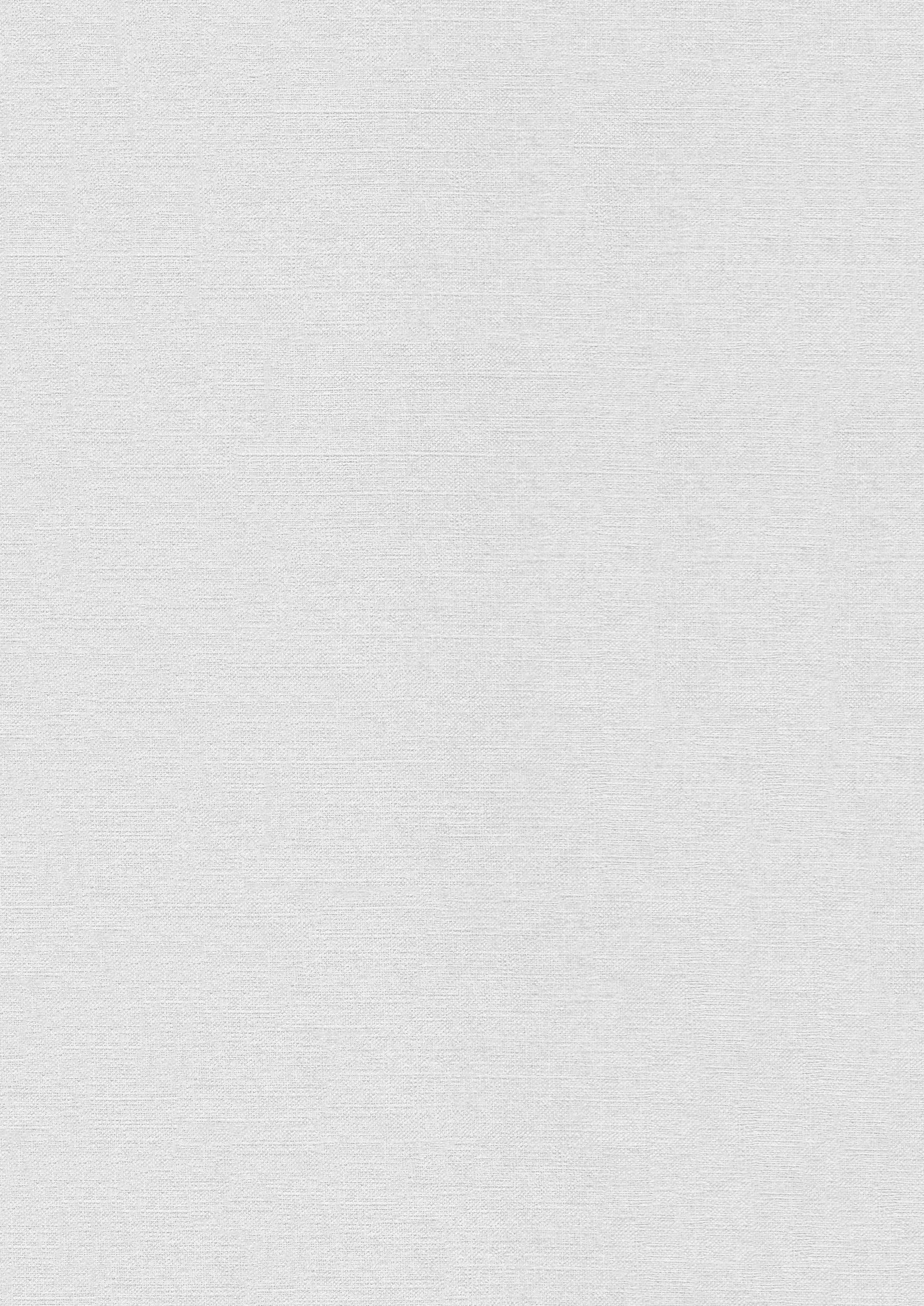
2 Visual Essay: A Detective From the Future
2.1
3 Site Technical Drawings
3.1
3.2.1
2.4
2.4.1
4 Unit 10 Proposal: Unofficial History

1.1 Introduction: a deduction of the ordinary world
we read the reality like detective
What makes detective novels so appealing?
Through the verses of the quirky song, Breaking into the locked chambers; The hidden drawer, revealed at last, A secret diary whispers secrets amassed.
Fingerprints captured by the vigilant cam, A bloody knife, carefully into a bag; Evidence pieces on the board align, The final witness, his findings define.
All detectives, raise your pipes in cheer! Now, time to announce, drawing near, The murderer is unveiled, shadows releases,
The suspense lingers, the culprit is

-Zijue Wei Celebrating the beauty of incomplete
Illustrated Thesis
To Tell or Not To Tell
Analysing

1As claimed by many writers, such as P.D.James, “Traditional mystery is not about murder at all, but the restoration of order.” (Gentill, 2020) Different from other forms of literature as monologues, detective novels are dialogues puzzle games set by the author, and to be solved by the readers. In most cases, the readers are the real “detectives” instead of the fictive detectives like Sherlock Holmes (Conan and Paget, 2011), who reveal the correct answer and explanation for the reader, as a part of the authors’ speaking. The readers of mysterious novels enjoy the process of piecing clues together as gradual process.
With these thoughts, try to bring the perspective of the detectives into the real world, into the field of narrative architecture. Space calls for action, and before action, the imagination is at work.” (Bachelard, 2014) Acting like detective, people build imagination and supplement the world they see: they may try to find a trace of a stain from passerby to identify their career or try to find the damage from a wall to reveal its history. As imagination operates, a thrilling epic comes across the watcher’s mind from the dull reality, boosting the excitement of these “detectives”.
However, too many details spoil the story. Once in the confession phase, the “criminals”, the objects of their observation, start to talk about every detail from their story, that redundant information erases the initial passion and enthusiasm of a heroic epic from the imagination. When epic degenerates into slice-of-life story, the passion in the narration vanishes in the trivial things.
Good storytelling is not to tell everything in the storyline, but to have a clear idea about the parts to be told or not. Similarly in narrative spaces demanding a strong emotional empathy, such as memorials, how can the designer gain delicate control over the concrete evidence as the base of the narration, and the void space to be filled by the reader’s imagination, creating stronger echo? This places me in both the perspectives of the authors as the puzzle makers, and the readers who challenge the puzzle, will analyse the way of creating satisfying experience for both roles, especially in the narrative context of historical memorials:
What kind of given evidence turns ruin into a memorial?
How do the given evidence and voids make a more powerful spatial narration?
What are the relationships within memorials, about real artefacts and voids in communicating and narrative?
1.1.1 Inspiration: Detective Novels

1.1.2 Literature, architecture and archaeology
Naturally, the ruins left over also left huge number of puzzles about the past, to be solved by archaeology scholars. And some of them turn into memorials, for “memorizing” and “telling the history”.
Most memorials are set up for those places, people or cultures erased or destroyed in wars, disasters, etc. The remains of the past such as buildings, artefacts, and other records including text and visual records, can be evidence of the puzzle. “The order of the past world” is restored through observation, deduction and imagination by the audience who performs detectives or archaeologists.
In this study, the methodology from archaeology will be borrowed, since they share a similar spirit and rationale in puzzle solving. Although architecture is always linked with archaeology, especially when using architecture as a medium of collecting evidence, we are not going to discuss the relationship between them again. From more literary and poetic point of view of a “detective”, with a little desire for self-pleasing and entertainment we see the spaces differently, and closer to narrative architecture to be felt, instead of simple observations of the ruins.
One important factor which differentiates our story-telling architecture from archaeology study is the accuracy of information: archaeology scholars value the reliability of information, by seeking every detail from the relics. Nevertheless, if we give up the obsessiveness in accuracy, and instead, go for more abstract term about feelings and atmospheres, we get closer to the field of narration, which relies less on the concrete details. As discussed in the book
Elements of Architecture (Bille and Sorensen, 2016), look more into the atmosphere of a place, instead of the tangible materials or structures.
However, all the evidence is not equally destroyed or protected. Due to the intensity, duration and ways of destruction caused by the events, different forms of evidence are kept by the memorials and make different narrations.
2
1.2.1 A daily life epic
Being detective of the dull reality
What can be the evidence of a space?
In mysterious novels, detective would rely on multiple sources of information to solve the puzzle, such as:
a. Physical evidence that can be seen or collected.
Physical damage
Stains and traces
Footprints and fingerprints
Etc.
b. Witness, real or fake, who gives a subjective description of their experience.
Innocents
Accomplice
Criminal
Etc.
c. Other information such as astronomy and synoptics to identify time.
d. Etc.
However, in reality, we need to rely on other more direct evidence as ordinary audiences. For the more approachable elements for the public as observers:
a. Location
b. Time
c. Material
Materials that are widely used at certain times
Materials mass-produced at certain places
Etc.
d. Structure
Identifiable building styles from certain cultures and time
Technologies mastered by certain group
Etc.
e. The records from different individuals
Diaries and messages
Drawings and videos
Recordings
Archives
Etc.
f. Etc.
In more professional and academic field, architecture, as an important medium of recording history, has been valued by many archaeologists and historians. But for ordinaries, architecture also means more than a space but is an information source which provides the memory about the past, a feeling of being alive, and a sense of belonging to the domestic area or space. Sitting comfortably at home, we are constantly offered images of how we should live our domestic lives, or of how others live theirs. (Brooker and Stone, 2013) Beyond these, architecture offers more information about the history which is readable for ordinaries, about the concept of nation and domestic culture, a shelter formed by such collective memory which roots in its people’s mind. Thus, such information is frequently conveyed through this evidence, through the recognizable style of the room, the location of the objects and the perceptible temporal sense of temperature and humidity. The memory of the individuals, the country, the nation and the certain spirit, is to be expressed by the architecture, from its narrative instinct (Coates, 2012). From these direct depictions, the imaginations start to grow to complement the narration.
Unfortunately, as both archaeologists and detectives, we must face the badly destroyed evidence even in daily life, which hardly tells anything, and demands a lot of brain work to put the truth together. The most objective reason for the amount and quality of the artefacts/evidence is the level of destruction and protection. The evidence can be destroyed throughout time, which leads to one of the key discussions in this thesis:
How do different amounts, forms and quality of evidence affect the way people perceive a spatial narration? How do different types of evidence work together to tell an emotive story, and how does it make the narration of the memorable past?

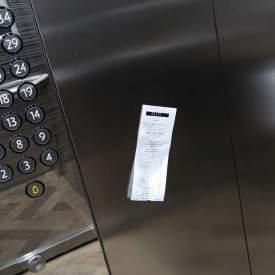
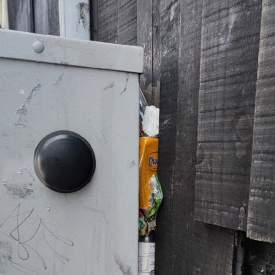

“Constant humidity”
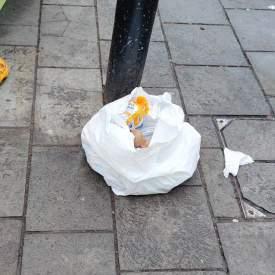
“Bought


“Unique floor tile” “Careless fixing”






1.2.2 The ruins as memorials
Precedents of the narrative ruins, performing the roles of memorials

Different types of evidence give different information and tell different stories. For example, the material or the structure not only gives a clue about the construction location, method and culture but also records the changes made to such material, such as cuts and stains.
When the amount and clarity of the evidence is sufficient for the audience to create an overview of the story, the imagination starts to operate to finish the narration. (Bachelard, 2014) However, not all the ruins have enough details and information to work as adequate evidence. All different factors, including the level of protection and destruction, the types of evidence, and the way how evidence links, can affect the way the ruin is perceived, and can finally decide whether this space can be used as memorial.
An unfinished space is to be filled, when enough evidence is given to shape the outline. The audience tends to see ruin as a complete architecture before destruction, or a prediction of the site’s future when there is sufficient information supporting the complement. The city constitutes a rich theatre of memory that melds all the senses in ways that suit every single one of us, in our capacity to combine instinct and knowledge, rational understanding and the imagination. (Coates, 2012) And when pieces of evidence come together, they give new stories as assemblages. (Bille and Sorensen, 2016) The interconnection between evidence gives new meanings. In the following part, list of ruins will demonstrate how the remaining parts are used as memorials of certain history or technology in these spaces, and how well they are helping with the spatial narration and spiritual resonance. We can give a brief diagram about how different types of evidence indicate different stories seen in the precedents:
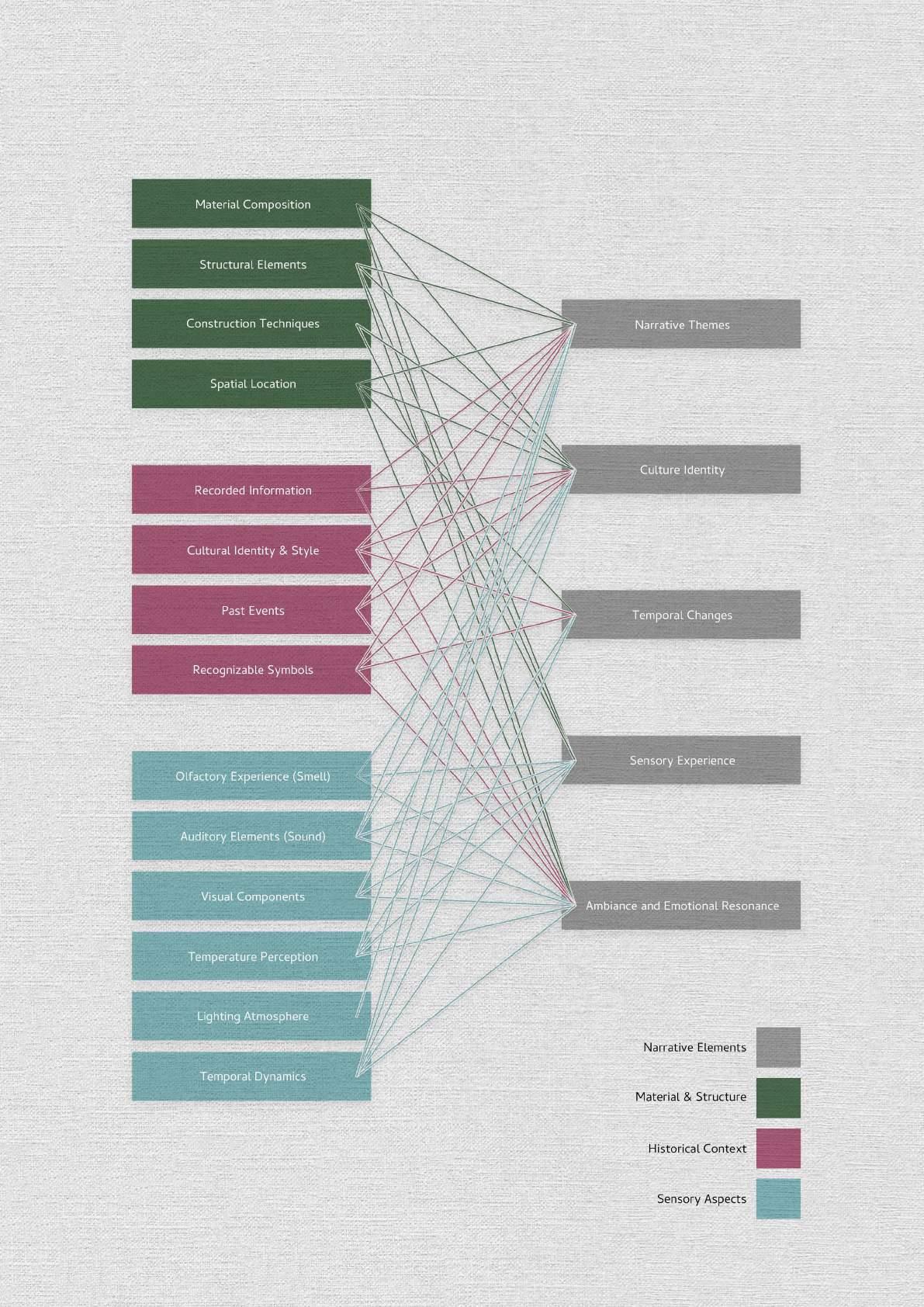
Memorial to the Murdered Jews of Europe
1.2.3 The ruin as a memorial
Theatre of Dionysus
Destroyed elements: Past events, recognizable symbols, recorded information
Remained elements: Material composition, structural elements, spatial location, cultural identity&style
As building constructed in the 6th century BC, the stone structure allowed it to sustain its appearance and structure until now. The functions of the site can be easily told from the structure without extra explanation, giving abundant details for the audience to fill the voids in both structure and atmosphere. The situation when the site was used thousands of years ago can be imagined based on the remaining structure.
Nanjing Porcelain Tower
Library of Alexandria
The Motherland Calls
Theatre of Dionysus
Nanjing Porcelain Tower
Theatre of Dionysus
Consequently, the ruin works well as memorial itself, without further need for repair. However, the protection is still needed to prevent further destruction.

Nanjing Porcelain Tower
The Motherland Calls
Memorial to the Murdered Jews of Europe
Memorial to the Murdered Jews of Europe
The Motherland Calls
 Figure The assemblage of elements and the narrations they make
Figure The assemblage of elements and the narrations they make
1.2.4 Repaired ruin as a memorial
Nanjing Porcelain Tower
Destroyed elements: Structural elements, construction techniques
Remained elements: Material composition, spatial location, recorded information, cultural identity&style, visual components
As the Porcelain Tower was destroyed in the rebellion of the Taiping Heavenly Kingdom in 1856, the tower remained destructed till the repair project in 2007. (Yu, 2016) Since the tower was demolished, the ruin itself tells nothing as pile of coloured glaze and porcelain without certain arrangement, giving an urgent need to restore the original structure to give better image of its history.
Due to multiple reasons such as safety and the protection of the old structure, the repair team used glass and metal instead of porcelain and coloured glaze. By holding up the remaining pieces from the old tower to their original position, the team tried its best to restore the tower and reuse the interior space as brand-new museum space about the history of Buddism and decoration culture. The base of the tower remains in front of the tower’s restoration, giving the visitors an idea of the original tower.



1.2.5 Redundant voids
Memorial to the Murdered Jews of Europe Peter Eisenman
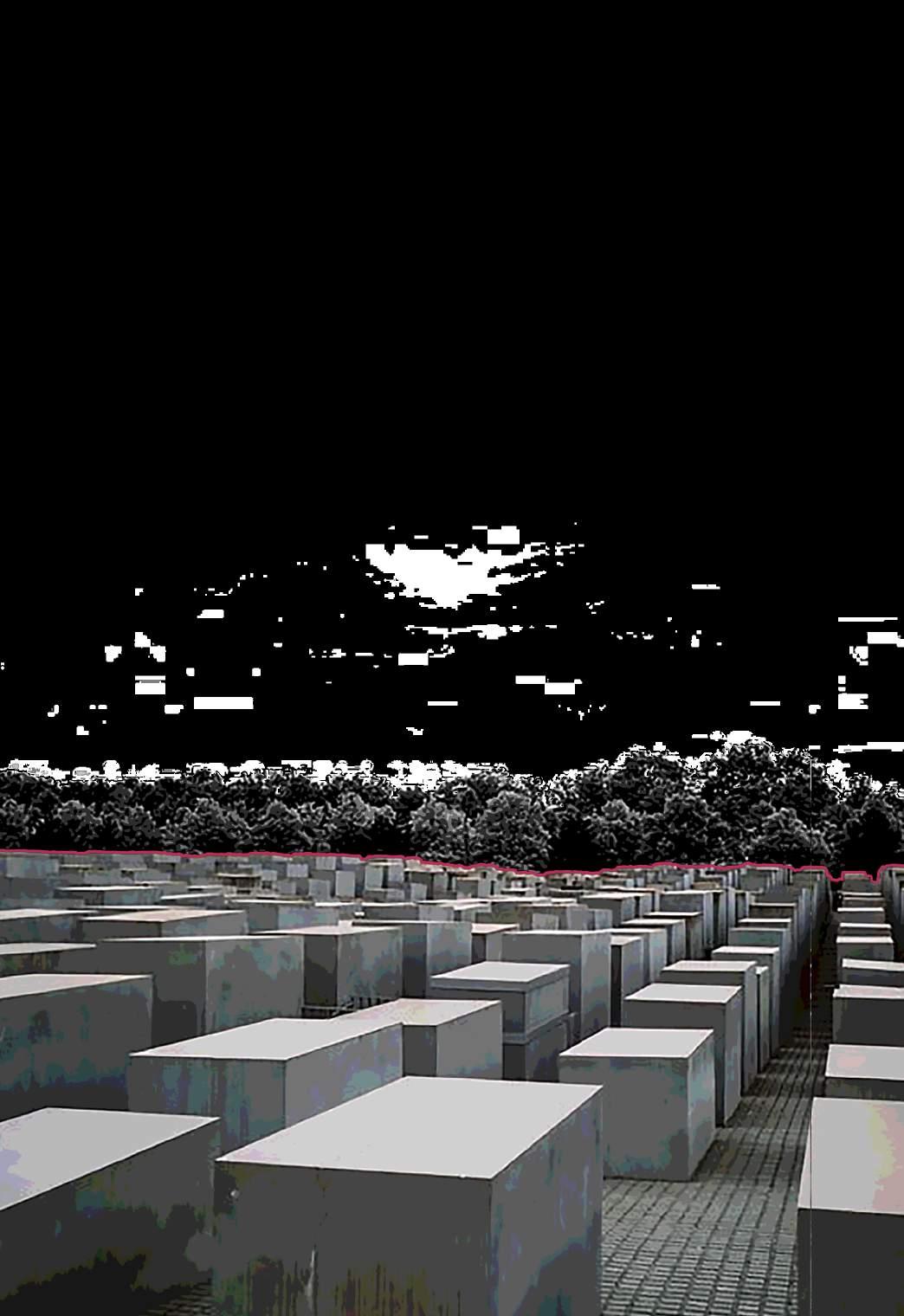
1.2.6 A renovated site of the spirit heritage
Missing elements: Spatial location, cultural identity&style, recorded information, past events
Exhibited elements: Material composition, recognizable symbols, visual components, temporal dynamics
The memorial for the murdered Jews consists of countless cement boxes, with the victims’ names engraved on them.
Alongside the exterior space, an Information Bureau is located at the eastern edge of the site, offering more information about the victims, and giving clearer guidance on visiting the site.
Similar to The Motherland Call, this memorial is also about an event without using the real location where it took place, but was presented in a different form. The plain cement boxes give enough space for imagination, as people might imagine these boxes as coffins or graveyards. (Kistenmacher, 2017)
However, the separation of the boxes and information centre also causes problems. Without being aware of the history, the cement boxes seem pointless, as they do not give clear self-declaration of what they represent, leaving too much space for imagination, and causing misunderstanding. Even when knowing the story behind it, the vague meaning behind this memorial is still questioned and criticised due to political reasons, for the meaning of “shame” and “threat” behind the memorial. (Kistenmacher, 2017)
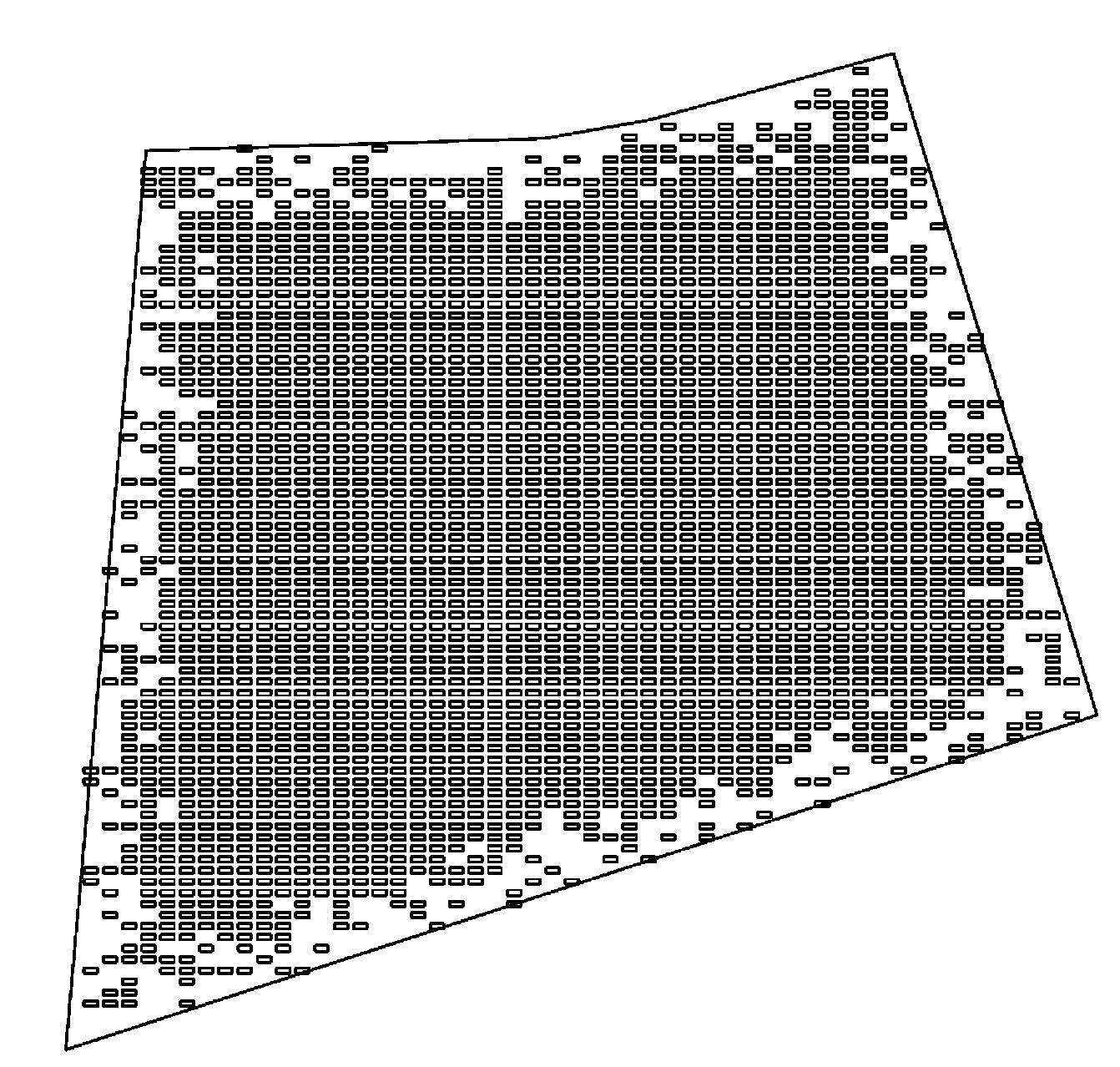




Missing elements: Material composition, structural elements, construction techniques, recorded information Exhibited elements: Spatial location, cultural identity&style, past events
In the field of memorials, the Library of Alexandria is very special. The destruction time of the library is still unclear, and what we can see today is only the ruin of the building’s base. Meanwhile, accurate records of the library structure are missing, which means that we can hardly see clear image of the building.
Due to the high level of destruction of the library, the evidence is in serious lack, and for sure, it is not enough to provide details for a complement. To resurrect the library, the modern Bibliotheca Alexandrina was built. The spirit of the scholars revived in a more contemporary way, but of course, the new library is no longer strongly relevant to the original one.
However, the old library is still in need of restoration in my opinion, since it represents an age of scholars with rich historical and cultural meanings. Meanwhile, the repair of the site could reuse the ruin, and bring people’s attention back to the original library’s structure.
1.2.7 A virtual character as the memorial
The Motherland Calls Yevgeny Vuchetich,
Missing elements: Material Composition, structural elements, spatial location
Existing elements: Recorded information, cultural identity, past events, recognizable symbols, visual components, lighting atmosphere, temporal dynamics
The statue of the woman as a memorial of the Battle of Stalingrad in 1943, did not use any real sites nor any real pieces from the battle but was presented as a human figure statue in the Soviet style of socialist realism. (www.visitrussia.com, n.d.) This feature makes it a very special instance among our listed memorials since it did not include any spatial elements about the war, but a female figure as collective memory of locals. “There is a simple rule of thumb that holds true for most of them: the bigger the event being commemorated, the bigger the monument. (Lowe, 2021) The huge monument makes the historical narration impressive and powerful, even without any statistics or records about the battle.
The symbolic figure of woman holding sword endows the memorial with an extremely powerful emotional expression among the viewers who share similar cultural and national backgrounds. However, without clear notification about the story behind the statue, the emotion and narration conveyed get relatively untenable, without the backbone of the touching story in the history of the battle.



1.2.8 Summary: The necessary evidence to be retained

1.3 Mutualism: the voids opposite to evidence
The void space only operates when evidence exists
Regarding the precedents and different methods of expression in ruins, whether the ruin can be turned into memorial full of emotional expression hinges on multiple factors:
a. The amount of evidence to be appropriate: too little evidence makes the space pointless, too much evidence makes the space dull;
b. The type of evidence to be appropriate: the wrong evidence gives redundant information, the right evidence gives a stimulation;
c. The interconnection between evidence to be appropriate: the evidence without connection distracts the audience, the evidence with clear connections brings the story together.
From the perspective of the designer, whether evidence is to be exhibited, the way it is exhibited, and the layout of the evidence, need to be considered seriously, no matter when building a memorial from ruins or without any physical artefacts remaining. When the selection of exhibited pieces of artefacts is successfully made, the narration of the space and the recall of the past and memory can be stronger, leading to a better consequence not only in the field of architectural design but also in social and educational aspects.
However, is it sufficient to include evidence only? The proportion of evidence in narrative space is inversely proportional to the void space, which gives no information in these spaces. When the spatial elements giving evidence fill the whole space, the story still tops over to the dull side.
The untold part of the story the voids in space, was proved to be an essential matter in story-telling or visual communication. In Chinese ink paintings, these blank spaces are called “intended blanks”. (Kafedjiska, 2019) In graphic design, they are called “white space” or “negative space”. (Ang, 2022) In stories, there are named “open endings” and “flashbacks”, aiming to leave a blank part in the story. (Learning & Creativity Team, 2019) The narrative part of the space is to be created by the readers or audience, but not the writers and designers. This self-driven narrative construction often produces a more impactful and resonant experience for the audience.
The space cannot be complemented when too little evidence is given, which is the cornerstone of the narrative atmosphere.
In the following chapter, will endeavour to engage in the other side of the space: the voids, from the perspective of the audience, who complement the space with their subconscious imagination.
Like the dichotomy of narration and audience, the void space contrasts with the evidence space, which provides evidence and cannot exist without each other. In ruins, voids exist naturally due to past damage; and in man-made narrative space, voids exist inevitably because of people’s movement in these spaces. In this chapter, the importance of the voids in memorial spaces is to be discussed, and the way different assemblage of evidence helps to build narrative memorial.
Gestalt psychology, effective not only in visual communication but also in narration and imagination (The Gestalt Centre, 2015), enables detectives to solve problems by complementing the logical chain of evidence. In fields such as literature, visual communication, or architecture, “filling the gaps” is a unique pleasure.
There are so many things to be put into a void: if the structure is missing, we think of a complete image of the whole building.
If the space is not in use, we imagine the way different people occupy and utilize the space. If the space is ruined, we think of the most splendent moments. The void can either be filled with substances, like the structure consisting of different materials, or events conducted by different people.
Bernard Tschumi’s notion of the pleasure of architecture, defined as the transgression of space or “disturbing space”, resonates with the act of complementing void spaces.
(Tschumi, 1996) In narrative construction, disturbing space refers to the conceptual and imaginative add-ons that redefine and utilize a space beyond its original forms. When people complement a space for unaware entertainment, the imaginative and conceptual add-ons turn the narrative spaces into a whole, by different manners from different people’s self-projection, and consequently “the original order of the space” comes with variety of interpretations, and in the imagination, the space gradually loses its initial form and state.
Due to the characteristics of different individuals, the complement to the void space can be very different. To solve the mystery of Venus de Milo, people create thousands of interpretations and creations for her arms (Fessenden, 2015); The audience makes up the space in countless manners, and each of them makes a powerful echo/resonance in the voids in both the space and atmosphere, even without communications among them. In communicating ideas through these void spaces, diverse interpretations strengthen and diffuse narratives beyond direct depictions.
Since the “deduction of space” works only when evidence is provided, according to different amounts of evidence given, people automatically take different strategies to complement the space and the effects of such deduction change. The different manners can be simply divided into 3 types, according to the amount and type of evidence provided.
1.3.1 Case Study: Coining from almost nothing
In memory of HU Huishan Liu Jiakun
For detective novel lovers, coining space from nothing helps to explain the trickiest mysteries and make the most creative imagination from the original text. However, this manner distorts the story that was meant to be told accurately and allows diverse reactions from the audience, leading to a weaker emotional reaction and attention to the truth.
In spatial narration, coining up space is also useful, especially when there is minimal amount of evidence left behind, such as small objects as personal possessions, and visual or text records describing the history. From these pieces of objects without telling the spatial context, spatial background is coined up by the audience, under the strong self-projection onto the story and with the Montage of pieces of information.
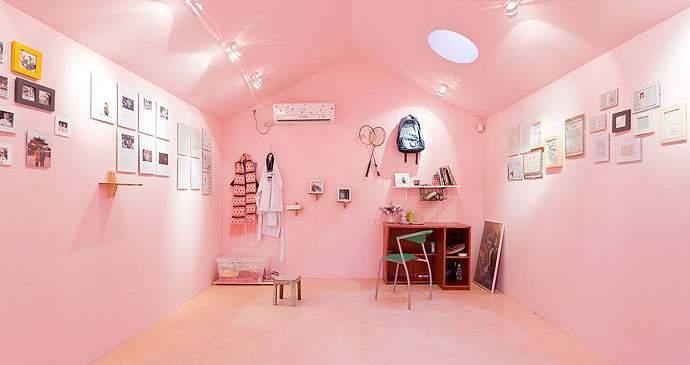


In the exhibition, with the smallest trace of the girl’s life but without any detailed descriptions about her space, the audience could build up an immaterial and ethereal room where she lived – the space does not necessarily have certain shape or layout, or any delicate details, but sense of existence, an image of a living one from the perspective the viewers, a memorial of someone who used to occupy the room, a perceived absence of the living character due to the Sichuan earthquake of 2008. In this case, the inexisting space is “coined” from nothing but group of scattered marks from the girl’s life. However, without brainwork, the pieces of evidence can easily be seen as their superficial appearance, instead of the deeper meaning of memorizing someone and her life. Meanwhile, due to the national background of the exhibition, there can also be gaps between the exhibition and the audience, bringing larger barrier to understanding.
As mentioned, the imagination about space does not happen exclusively. No matter the extent or the creativity of the imagination, it demands a concrete starting point, which shows up as the girl’s possessions in the case study. In this situation, the proactivity, subjectivity and relevant knowledge of the audience are strongly demanded due to the missing details of the space, due to the huge number of details to be complemented.


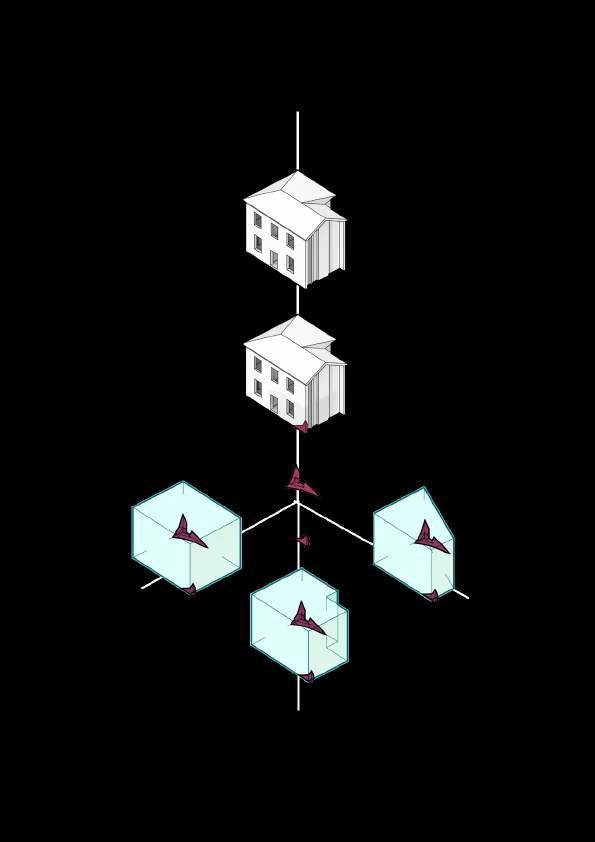
1.3.2 Case study: Supplementing to basic evidence
9/11 Memorial and Museum - Michael Arad &

Like in detective novels where readers deduce the crime scene from concrete evidence, supplementing details is more pragmatic than coining from nothing. There is usually a clear outline or larger pieces of spatial structure remaining, to give more concrete evidence and a smaller void to be filled. And surely, this form of expression usually makes a more reliable and realistic narration, compared to coining.
Other than spatial structure, other more detailed evidence could help to build up the narration. For instance, trace of fighting on the wall would support restructuring the whole storyline.
In this case study, with a very appropriate name given: Reflecting Absence, the void spaces of the old towers “make the absence visible” (9/11 Memorial & Museum, 2000), by contrasting the subconscious imagination of supplementing the space and the reality of the empty pools. The empty pools where the building base used to be, indicate the original location of the towers and depict scenery like erasing the tower from the earth drastically. However, the image of the towers still exists in an intangible way of perceiving them, reminding people of the grievous past.



From the missing, people create an invisible projection of the time before the disaster under the overwhelming emptiness and loneliness. The empty pools leave enough physical and spiritual space for the imagination to supplement these voids but also give enough clues of what used to happen, by engraving the victims’ names on the pools’ edges, and flowers left by the mourners. Through the interpretation of the audience, these voids are filled through the awareness of the disaster’s history, such as the memory of the old World Trade Centre, or the living images of the victims.


1.3.3 Case study: Recomposing the given pieces
Recomposing is more like a mix-and-match of the abundant given evidence but without enough interconnections between them. It depends on reality, the reliable and trustable evidence provided by authorities, but with a little creativity by blending the timeline or the sequences of using the space. Consequently, this manner demands the most information and gives the least void to be filled.
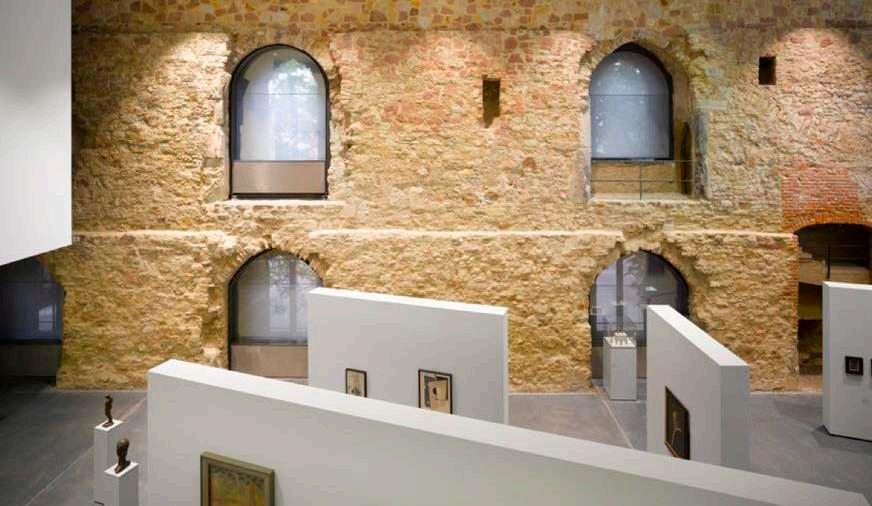


In this case, recomposing the space demands clearer images of the old structure, such as the worn walls and broken windows, the parts that existed from history. The Thirty Years’ War (1618–1648) did not remove every piece of the old castle but also left unique symbol of the decoration style and history of the building, a sense of vintage and a reminder of the past. (Archdaily, 2011) The concrete new structure renewed the castle as a gallery, and did not leave a lot of space for imagination but tangible museum space, a successful combination of old and new, giving the images of the castle at the same time.
Since the old structures remaining are rejoined with white modern structures, the functions of the original space are somehow erased and replaced by new spaces. But through the outlasting details on the old castle wall, the evidence can be linked together by the audience, to form an image of the old castle with the remaining pieces, and the idea of the new structure along with the modern extension.
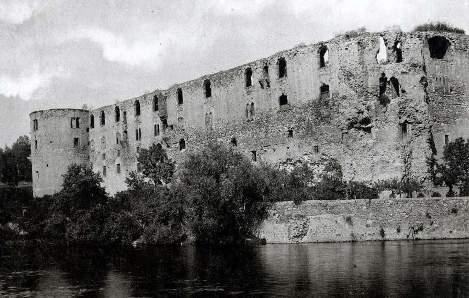

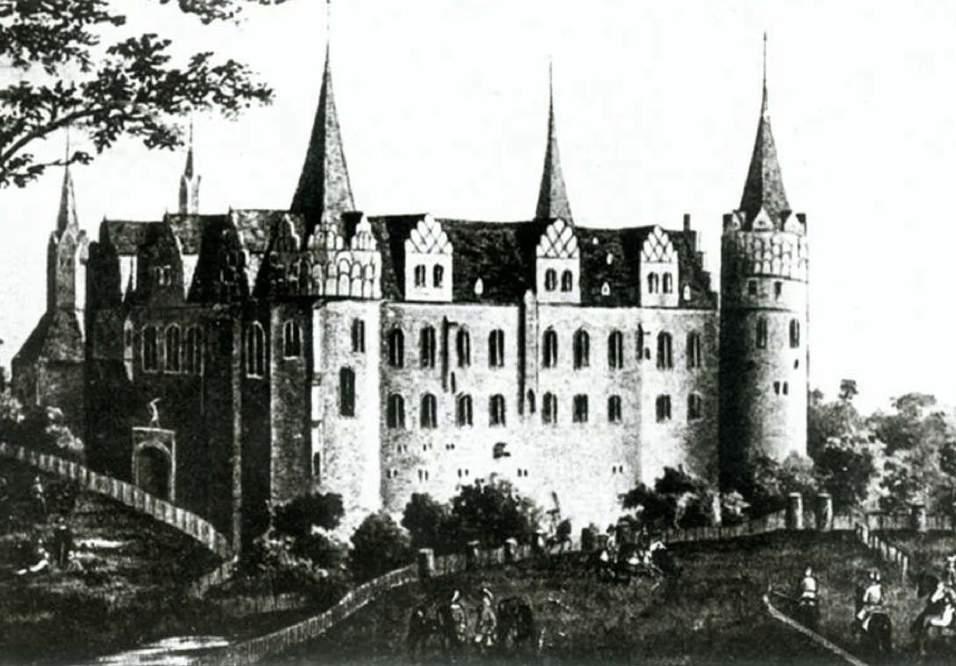
1.3.4 Summary: The deafening voice from the void space
Based on the study above, we must note that the voids we are discussing can easily be confused with “negative space” or the so-called “white space”. Though they are usually seen especially in exhibition spaces, surrounding the exhibited work, their purposes differ from the void spaces. Negative spaces are designed to ensure the main body of the exhibition stands out, while the negative spaces never speak.
But voids do have a certain representation of emptiness and absence, just like an unknown but existing space, which makes a powerful voice when enough evidence is given. The different purpose leads to diverse strategies for using these void spaces and consequently endow them with different meanings.
The voids – the spaces born to be filled but necessarily remain empty, no matter by physical matters or virtual imagination, make the mighty voice from its emptiness, as the audience automatically complements these parts in different manners. Like the evidence space, the void space needs to be thought over, and more, to balance with the evidence.
With the information provided by the designers, the void space gains its meaning in the audience’s minds, complemented by their knowledge and imagination, projected onto the narrative space. Though everyone feels the same space differently, the empathetic connections created by the evidence and echoing in the void are linked. In some cases, a cultural or national memorial attracts and touches more domestic people, since the audience has similar feelings, based on their common cultural background, such as the memorials about national wars.
As discussed, the void space does not only conduct the function of transitional and circulation space but also gets its own meaning, according to the evidence allocated for them. As a very key element in narrative spatial design, it requires more attention and consideration from designers, by considering the roles and positions of the void spaces in spatial designs, and their functions in more than simply negative space as background or circulation spaces.
1.4 Conclusion: The collaboration of evidence and voids
Other than the field of narrative space, the issue of whether damaged buildings should be repaired as their original forms are discussed throughout time.
In the mainstream discussion, people usually give variety of different ideas:
a. The buildings should be left damaged, to keep the damage as part of their history;
b. The buildings should be restored to their original form, simulating the original technology at the age of construction;
c. The buildings should be reused by adding new structures;
d. The buildings should be renewed with up-to-date technology and materials;
e. Etc.
Such discussion has been going on for years. From my perspective, the decision depends on the purpose of keeping and refurbishing these buildings. In responding to the pieces of “evidence” left in the building, and the event that caused such damage, the strategy varies.
For those buildings with remarkable construction techniques from certain age, it may be better to be restored with the former or up-to-date techniques. By revising the structure, material and technology used, people gain better understanding of the history and continue to redevelop the construction techniques based on these.
However, if the focal points of the memory are an event, such as accidents, wars, or disasters, then the “damage” itself is to be memorable. As a narrative space demanding intense emotional empathy, an appropriate void caused by such tragedies would evoke people’s emotions which give a more impressive image and understanding. Illustrated in the precedents about the memorials above, a clear idea of the mood echo in the void space was discussed and analysed.
At such a moment, the clue of the former existence of the building needs to be mentioned and exhibited. The emotion of the space relies on basic clues to perform. A given piece of evidence can be the story behind character, a short history behind the tragedy, a piece of object that survived the event, or another visual or textual record. By giving the “void” a slightly clearer idea, the understanding towards such “voids” can be directed, to strengthen the emotional resonance.

As recent instance, for the Notre Dame de Paris, partly destroyed in 2019 by fire, he (President Macron) announced a competition to allow contemporary artists to recreate six of the stained glass windows on the southern side of Notre Dame, in order to ‘mark this 21st century.’ (Colliva and CNN, 2023) By keeping both the original structure of the building and adding new parts to the damage, the meanings of both the cultural value and the memorable disaster are remembered.
1.5.1 Reference list
9/11 Memorial Museum (2000). Home National September 11 Memorial & Museum. [online] 911memorial.org. Available at: https://www.911memorial.org/ admin (2022). Porcelain Tower of Nanjing. [online] Chinarmart. Available at: https://chinarmart.com/2022/06/20/porcelain-tower-of-nanjing/ [Accessed 19 Jan. 2024]. Ang, (2022). Using White Space in Design: Complete Guide. [online] Venngage. Available at: https://venngage.com/blog/white-space-design/#:~:text=White%20space%20 is%20one%20of
Anon, (n.d.). 9/11: The 25 Most Powerful Photos. [online] Available at: https://news.yahoo. com/9-11-the-25-most-powerful-photos-1315611364-slideshow?guccounter=1&guce_referrer=aHR0cHM6Ly93d3cuZ29vZ2xlLmNvbS8&guce_referrer_sig=AQAAANmsjEufK2O3Uk-tQLHCamDN1iTiQDGVp7Kz4DPEKE0K5nICWW4cqBG2-zz7yNRqGCA2k_Qe9lOTVFX8cuKlXucISlDlhOPFK2Od1QmLOdFjMPUjeiThdd7Y0G5xxRtFUjKHe13scoHOKNyif3R5vgH-pxxal-nfYZNe6vYsAKkJ
Anon, (n.d.). The Motherland Calls Mamaev Kurgan in Volgograd, Russia. [online] Available at: https://www.ritebook.in/2014/03/Motherland-Calls-Mamaev-Kurgan-Volgograd-Russia-Monument.html [Accessed 19 Jan. 2024]. Archdaily (2011). Moritzburg Museum Extension Nieto Sobejano Arquitectos. [online] ArchDaily. Available at: https://www.archdaily.com/132838/moritzburg-museum-extension-nieto-sobejano-arquitectos?ad_source=search&ad_medium=projects_tab Archdaily (2013). Hu Huishan Memorial Jiakun Architects. [online] ArchDaily. Available at: https://www.archdaily.com/363718/hu-huishan-memorial-jiakun-architects?ad_source=search&ad_medium=projects_tab [Accessed 14 Jan. 2024]. ArchDaily. (n.d.). Gallery of Hu Huishan Memorial Jiakun Architects [online] Available at: https://www.archdaily.com/363718/hu-huishan-memorial-jiakun-architects/5176c56cb3fc4b74870001f7-hu-huishan-memorial-jiakun-architects-photo?next_project=no [Accessed 19 Jan. 2024]. Bachelard, G. (2014). The Poetics of Space. New York: Penguin Books. Berger, J. (1972). Ways of Seeing. Edmonton, Alta.: The Schools. Bille, M. and Sorensen, T.F. (2016). Elements of Architecture. [online] Available at: https:// www.taylorfrancis.com/books/edit/10.4324/9781315641171/elements-architecture-mikkel-bille-tim-flohr-sorensen [Accessed Nov. 2023]. Bordes, D. (2023). Notre Dame Cathedral Reconstruction Progress Update 2023. [online] www.friendsofnotredamedeparis.org. Available at: https://www.friendsofnotredamedeparis.org/notre-dame-progress-update-2023/ Brooker, G. and Stone, S. (2013). From Organisation to Decoration an Interior Design Reader. London: Routledge. Christie, A. (2019). And Then There Were None. S.L.: Harpercollins Publishers. CNN, N.F. and B.W. (2018). A decade on, heartache of deadly Sichuan quake still being felt. [online] CNN. Available at: https://edition.cnn.com/2018/05/11/asia/sichuan-earthquake-anniversary-intl/index.html
Coates, N. (2012). Narrative Architecture. Chichester, West Sussex Hoboken, N.J.: Wiley. Colliva, C. and CNN (2023). Inside the $760M restoration of Notre Dame cathedral. [online] CNN. Available at: https://edition.cnn.com/style/notre-dame-cathedral-restoration/index. html [Accessed Jan. 2024].
In conclusion of the thesis, through studying and comparing the intended voids in literature and architecture, the key argument is demonstrated that in a narrative space especially memorials of the past, the space giving evidence and void spaces must be carefully balanced, not only by giving appropriate amounts and types of evidence but also leave an appropriate void space in between to include the audience as an observer of the narrative space, and allowing subjective and proactive complement to the narration, which induces a heartfelt emotional reaction and strengthens the narrative space. A balanced space with the two elements: space of evidence and void space, could make the most affecting narration, not only in creating resonance in the individuals’ minds but also leaving mark of common knowledge, which helps more with the whole society and the nation or civilization. The designers must build clear framework by thinking and guiding the way that the audience complements a space and provides suitable information about the site, to support the induced reaction from the audience and avoid possible misunderstanding by refraining from the vague meanings of the evidence and creating concentrated attention towards the theme of the memorials.

1.5.2 Images
Available at: https://www.archdaily.com/592824/ad-classics-bibliotheca-alexandrina-snohetta?ad_medium=gallery Learning & Creativity Team (2019). The ‘Open Ended Story’ Blue Pencil. [online] www. bluepencilpublishers.com. Available at: https://www.bluepencilpublishers.com/the-openended-story/ Lowe, K. (2021). The Motherland Calls: Mamayev Kurgan Monument. [online] Aspects of History. Available at: https://aspectsofhistory.com/the-motherland-calls-mamayev-kurgan-monument/ Luckhurst, R., King, S. and British Film Institute (2013). The Shining. Houndmills, Basingstoke, Hampshire: Palgrave Macmillan On Behalf Of The London British Film Institute. Ludwig, K. and Christie, A. (2019). Agatha Christie’s Murder on the Orient express. New York, Ny: Samuel French. Mostafa El-Abbadi (2019). Library of Alexandria Description, Facts, & Destruction. In: Encyclopædia Britannica. [online] Available at: https://www.britannica.com/topic/Library-of-Alexandria 難民.稻子 (2009). 我們的娃娃 365-020 守護胡慧珊紀念館 [online] 我們的 娃娃 Available at: https://womendewawa.blogspot.com/2009/12/365-020.html [Accessed 19 Jan. 2024]. Overstreet, K. (2020). Tale of Two Buildings: The Argument Behind Preservation and Reuse. [online] ArchDaily. Available at: https://www.archdaily.com/944306/a-tale-of-twobuildings-the-argument-behind-preservation-and-reuse [Accessed 14 Jan. 2024]. Richman-Abdou, K. (2018). The Mysterious History of the Marble ‘Venus de Milo’ Statue. [online] My Modern Met. Available at: https://mymodernmet.com/venus-de-milo-statue/ Ryukishi07 (2019). Umineko WHEN THEY CRY Episode 8: Twilight of the Golden Witch. Yen Press LLC.
The editors of Encyclopedia Britannica (2019). Theatre of Dionysus theatre, Athens, Greece. In: Encyclopædia Britannica. [online] Available at: https://www.britannica.com/ topic/Theatre-of-Dionysus
The Gestalt Centre (2015). What is Gestalt Psychology? The Gestalt Centre. [online] The Gestalt Centre. Available at: https://gestaltcentre.org.uk/what-is-gestalt/ Tschumi, B. (1996). Architecture and Disjunction. Cambridge, Massachusetts: The Mit Press. Visit Berlin (2000). Memorial to the Murdered Jews of Europe visitBerlin.de. [online] Visitberlin.de. Available at: https://www.visitberlin.de/en/memorial-murdered-jews-europe www.911memorial.org. (n.d.). About the Memorial National September 11 Memorial Museum. [online] Available at: https://www.911memorial.org/visit/memorial/about-memorial. www.christies.com (n.d.). Bao’ensi or the Porcelain Tower of Nanjing. [online] Available at: https://www.christies. com/en/lot/lot-5318015
Figure The leftover incomplete: Yuanmingyuan Ruin (Old Summer Palace)
https://zh.wikipedia.org/wiki/%E5%9C%86%E6%98%8E%E5%9B%AD#/media/ File:Ruins_of_Yuanyingguan02_20130126.JPG
Figure Detective novels used for investigation
Figure 3 Primary research: daily life epics
Figure 4 The assemblage of elements and the narrations they make
Figure 5 The ruins turned into memorials in different manners
Figure 6 Plan of the Theatre of Dionysus, built in the 6th century BC https://www.wikiwand.com/en/Theatre_of_Dionysus#Media/File:Dionysus-theater.JPG
Figure Photo of the Theatre of Dionysus
https://www.wikiwand.com/en/Theatre_of_Dionysus#Media/File:Athen_Akropolis_(18512008726).jpg
Figure Ancient drawing of Nanjing Porcelain Tower https://www.christies.com/en/lot/lot-5318015
Figure 9 Photo of Nanjing Porcelain Tower, built in the early 15th century https://chinarmart.com/2022/06/20/porcelain-tower-of-nanjing/
Figure 10 Plane of Memorial to the Murdered Jews of Europe Peter Eisenman, 2004 https://generativelandscapes.wordpress.com/2014/10/31/memorial-to-the-murdered-jews-of-europe-case-study-01-part-01-setting-up-the-plan/
Figure 11 Former inmates of German concentration camps who later became citizens of Israel
Figure 19 In memory of HU Huishan Liu Jiakun, 2009 https://www.archdaily.com/363718/hu-huishan-memorial-jiakun-architects/5176c56cb3fc4b74870001f7-hu-huishan-memorial-jiakun-architects-photo?next_project=no
Figure 20 Author’s concept: How “coining” works in spatial narration
Figure 21 Photo of 5.12 Wenchuan Earthquake Memorial Museum https://edition.cnn.com/2018/05/11/asia/sichuan-earthquake-anniversary-intl/ index.html
Figure 22 Photo of HU Huishan https://womendewawa.blogspot.com/2009/12/365-020.html
Figure 23 Author’s concept: How “supplementing” works in spatial narration
Figure 24 Photo 9/11 Memorial and Museum Michael Arad & Peter Walker https://www.911memorial.org/visit/memorial/about-memorial
Figure 25 The photo of the World Trade Centre taken during the attack https://news.yahoo.com/photos/9-11-the-25-most-powerful-photos-1315611364slideshow/?guccounter=1&guce_referrer=aHR0cHM6Ly93d3cuZ29vZ2xlLmNvbS8&guce_referrer_sig=AQAAANmsjEufK2O3Uk-tQLHCamDN1iTiQDGVp7Kz4DPEKE0K5nICWW4cqBG2-zz7yNRqGCA2k_Qe9lOTVFX8cuKlXucISlDlhOPFK2Od1QmLOdFjMPUjeiThdd7Y0G5xxRtFUjKHe13scoHOKNyif3R5vgH-pxxal-nfYZNe6vYsAKkJ
Figure 26 “On 9/11 people jumped to their death” https://news.yahoo.com/photos/9-11-the-25-most-powerful-photos-1315611364slideshow/?guccounter=1&guce_referrer=aHR0cHM6Ly93d3cuZ29vZ2xlLmNvbS8&guce_referrer_sig=AQAAANmsjEufK2O3Uk-tQLHCamDN1iTiQDGVp7Kz4DPEKE0K5nICWW4cqBG2-zz7yNRqGCA2k_Qe9lOTVFX8cuKlXucISlDlhOPFK2Od1QmLOdFjMPUjeiThdd7Y0G5xxRtFUjKHe13scoHOKNyif3R5vgH-pxxal-nfYZNe6vYsAKkJ
Conan, A. and Paget, S. (2011). The original illustrated Sherlock Holmes 37 short stories plus complete novel, comprising The adventures of Sherlock Holmes, The memoirs of Sherlock Holmes, The return of Sherlock Holmes, and The hound of the Baskervilles. New York: Castle Books. Dickson, C. (1959). Murder the Submarine Zone. Murder in the Atlantic. Erre, J.M. (2013). Le mystère Sherlock. Fessenden, M. (2015). The Mystery of What Venus de Milo Was Once Holding. [online] Smithsonian Magazine. Available at: https://www.smithsonianmag.com/smart-news/3-dprinting-offers-guess-what-venus-de-milo-might-have-been-holding-180955176/
Friends of Notre-Dame de Paris. (2021). Latest Reconstruction Progress Notre-Dame Restoration 2021. [online] Available at: https://www.friendsofnotredamedeparis.org/ reconstruction-progress/ Generative Landscapes. (2014). Memorial to the Murdered Jews of Europe Case Study 01 Part 01 Setting up the Plan. [online] Available at: https://generativelandscapes. wordpress.com/2014/10/31/memorial-to-the-murdered-jews-of-europe-case-study-01part-01-setting-up-the-plan/ Gentill, S. (2020). Reviving the Traditional Mystery for 21st Century Audience. [online] CrimeReads. Available at: https://crimereads.com/reviving-the-traditional-mystery-for-a-21st-century-audience/#:~:text=P.D [Accessed 14 Jan. 2024]. JCFalkenberglll (2023). Fighting on the territory of the ‘Red October’ factory, Iakov Riumkin, 1942. Source: MAMM/M DF. [online] Available at: https://www.reddit.com/r/ WW2info/comments/14dqto7/fighting_on_the_territory_of_the_red_october/ [Accessed 19 Jan. 2024].
京極夏彥 (1996). 鉄鼠の檻 Kafedjiska, (2019). The beauty, philosophy, and spirituality behind the Chinese ink wash painting. [online] Jungle Dancer. Available at: https://jungle-dancer.com/the-beauty-philosophy-and-spirituality-behind-the-chinese-ink-wash-painting/ Keigo Hagashino (1986). 白馬山荘殺人事件 Kistenmacher, G. (2017). Representation of the Holocaust through the Memorial to the Murdered Jews of Europe – Writing Anthology. [online] central.edu. Available at: https:// central.edu/writing-anthology/2019/04/11/representation-of-the-holocaust-through-thememorial-to-the-murdered-jews-of-europe/ Langdon, D. (2015). AD Classics: Bibliotheca Alexandrina Snøhetta. [online] ArchDaily.
www.kunstmuseum-moritzburg.de. (n.d.). Moritzburg Castle Museum & Exhibitions - Kulturstiftung Sachsen-Anhalt. [online] Available at: https://www.kunstmuseum-moritzburg.de/en/museum-exhibitions/moritzburg-castle/#collapseBox-7174 [Accessed 18 Jan. 2024]. www.visitrussia.com. (n.d.). The Motherland Calls. [online] Available at: https://www. visitrussia.com/citiesguide/volgograd/places/the_motherland_calls 西村京太郎 (2021). 七人の証人 Yu, E. (2016). China rebuilds ‘world wonder’ in Nanjing. [online] CNN. Available at: https://edition.cnn.com/travel/article/nanjing-china-reconstructed-porcelain-tower/index. html Yukito Ayatsuji (n.d.). 十角館の殺人 THE DECAGON HOUSE MURDERS Jukkakukan no satsujin. 講談社 Kodansha. Zhou HaoHui (n.d.). 鬼望坡 Ghost Hope slope Emotion Series (Chinese Edition).

https://www.eisenhowerlibrary.gov/research/online-documents/ world-war-ii-holocaust-extermination-european-jews
Figure 12 Photo of Memorial to the Murdered Jews of Europe https://www.pinterest.co.uk/pin/759701030903272098/
Figure 13 Photo of Bibliotheca Alexandrina Snøhetta, Christoph Kapeller and Ihab El Habbak
https://www.archdaily.cn/cn/946710/adjing-dian-xin-ya-li-shan-da-tu-shu-guan-snohetta/54c27ee0e58eced7eb00007c-201001_n151_publication-jpg
Figure 14 Artistic Rendering of the Library of Alexandria https://en.wikipedia.org/wiki/Library_of_Alexandria#/media/File:Ancientlibraryalex.jpg
Figure 15 Photo of the destroyed Library of Alexandria, built in 285–246 BC https://en.m.wikipedia.org/wiki/File:Alexandria_-_Pompey’s_Pillar_-_view_ of_ruins.JPG
Figure 16 Photo about the Battle of Stalingrad, 23 August 1942 – 2 February 1943 https://www.reddit.com/r/WW2info/comments/14dqto7/fighting_on_the_territory_of_the_red_october/
Figure 17 Photo of the sculpture The Motherland Calls Yevgeny Vuchetich, Nikolai Nikitin, 1967
https://www.ritebook.in/2014/03/Motherland-Calls-Mamaev-Kurgan-Volgograd-Russia-Monument.html
Figure 18 In memory of HU Huishan – Liu Jiakun, 2009 https://www.archdaily.com/363718/hu-huishan-memorial-jiakun-architects/5176c56cb3fc4b74870001f7-hu-huishan-memorial-jiakun-architects-photo?next_project=no
Figure 27 Photo of the World Trade Centre before the attack https://freerangestock.com/photos/38118/world-trade-center-new-york-city. html
Figure 28 Photo of Moritzburg Museum Extension Nieto Sobejano Arquitectos https://www.archdaily.com/132838/moritzburg-museum-extension-nieto-sobejano-arquitectos?ad_source=search&ad_medium=projects_tab
Figure 29 Photo of Moritzburg Museum Extension Nieto Sobejano Arquitectos https://www.archdaily.com/132838/moritzburg-museum-extension-nieto-sobejano-arquitectos?ad_source=search&ad_medium=projects_tab
Figure 30 The ruin of Moritzburg Castle in 1950 https://www.kunstmuseum-moritzburg.de/en/museum-exhibitions/moritzburg-castle/#collapseBox-7174
Figure 31 Author’s concept: How “recomposing” works in spatial narration
Figure 32 Photo of Moritzburg Castle before destruction https://www.kunstmuseum-moritzburg.de/en/museum-exhibitions/moritzburg-castle/#collapseBox-7163
Figure 33 The ongoing repair of the cathedral https://edition.cnn.com/style/notre-dame-cathedral-restoration/index.html
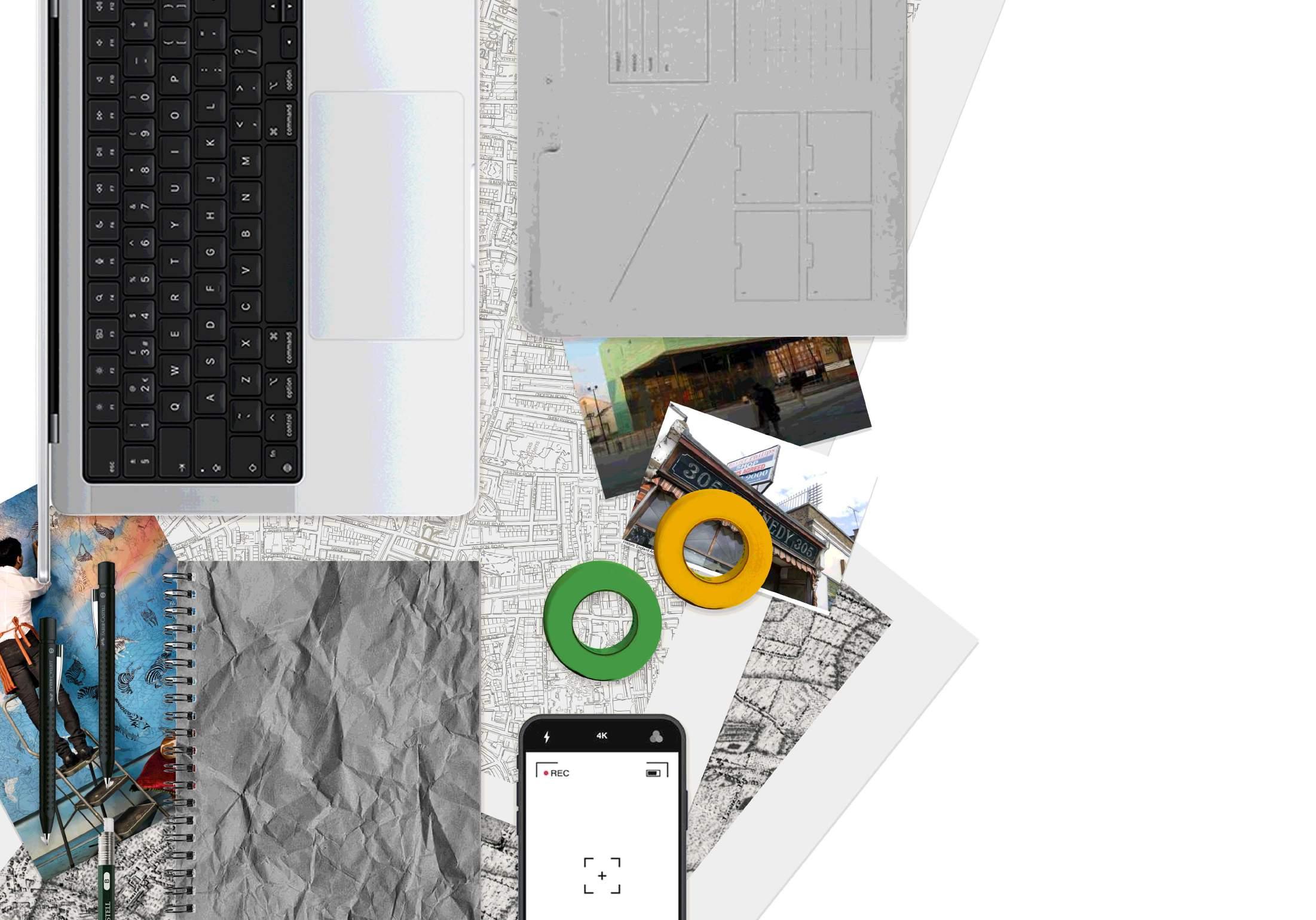
2.1 Personality expression and footprints
Show
2.2 Read someone through footprint
Visual Essay
A Detective From the Future
Invesitgating the way different individuals look at their history of the site, from the past, present and future
Zijue WEI
October 2023 - February 2024
Interior and Spatial Design Unit 9 Thesis University of the Arts London
2
Acting as a detective from the future, we are looking at everything before us: the earlier past, the past, and the present that we are now experiencing. Just like the way we see our history, no one can predict the way that people from the future are going to judge us. But imagining the future can still be thrilling – what will be our profile and story in the future history books?

Using the shoe as both representation of the individual and a tool to leave traces such as footprints, the owner of the shoe can be put into a position of being observed and observing, the criminal and the detective.


2.3.2 From traces to profile
Shaping a character based on their traces
A gentleman from the 19th century
A female worker working at the sausage factory in Peckham, from the end of the 20th century
By analysing the footprints made by the different parts of the shoe, a basic profile of 4 characters can be deducted from the evidence. Through the superficial appearance of the fake footprint, the imagination through these observations is still real.
The artist Raqib Shaw, who occupies the factory currently
Zijue, a student living in London currently, investigating the history of Peckham for her project

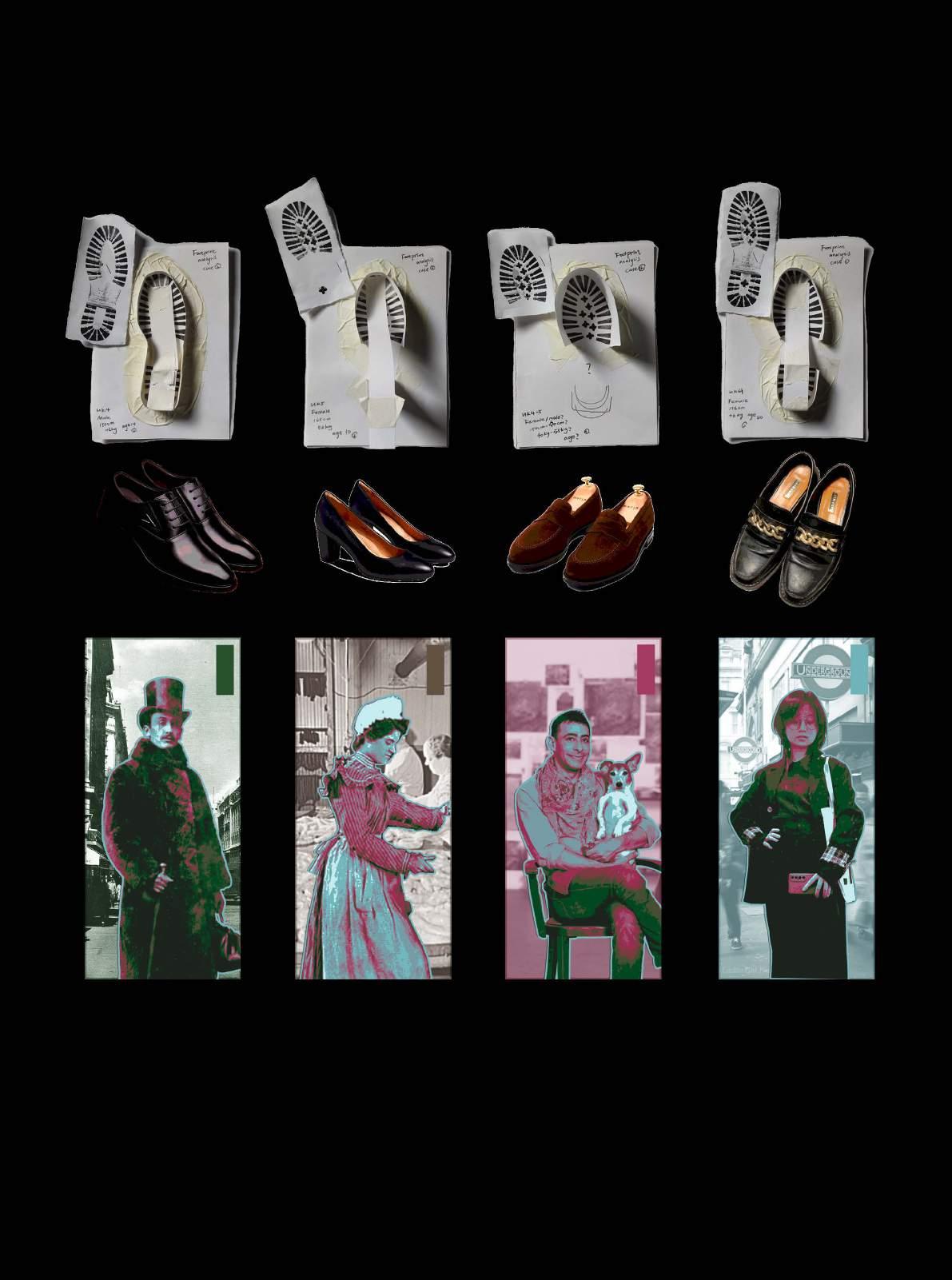
Sources of information used for the virtual investigation

Seeing the characters through layers of time
Imagining what detective would do when investigating the characters, we still borrow the methodology of archaeology, which is to search for evidence from various sources. In earlier history, the evidence came from soil; for the detective from the future, the evidence comes from the Internet.

2.3.5.1 A representation of the early past
First character’s detective map
Putting the found evidence together, a possible route made by these characters is marked on the detective map, on top of the Peckham map. We have basic idea of the daily life of these characters, by reproducing their daily life through their movements.

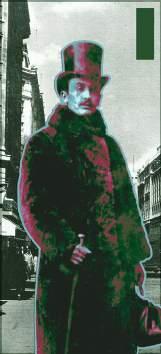
2.3.5.2 A representation of the nearer past
Second characters’s detective map
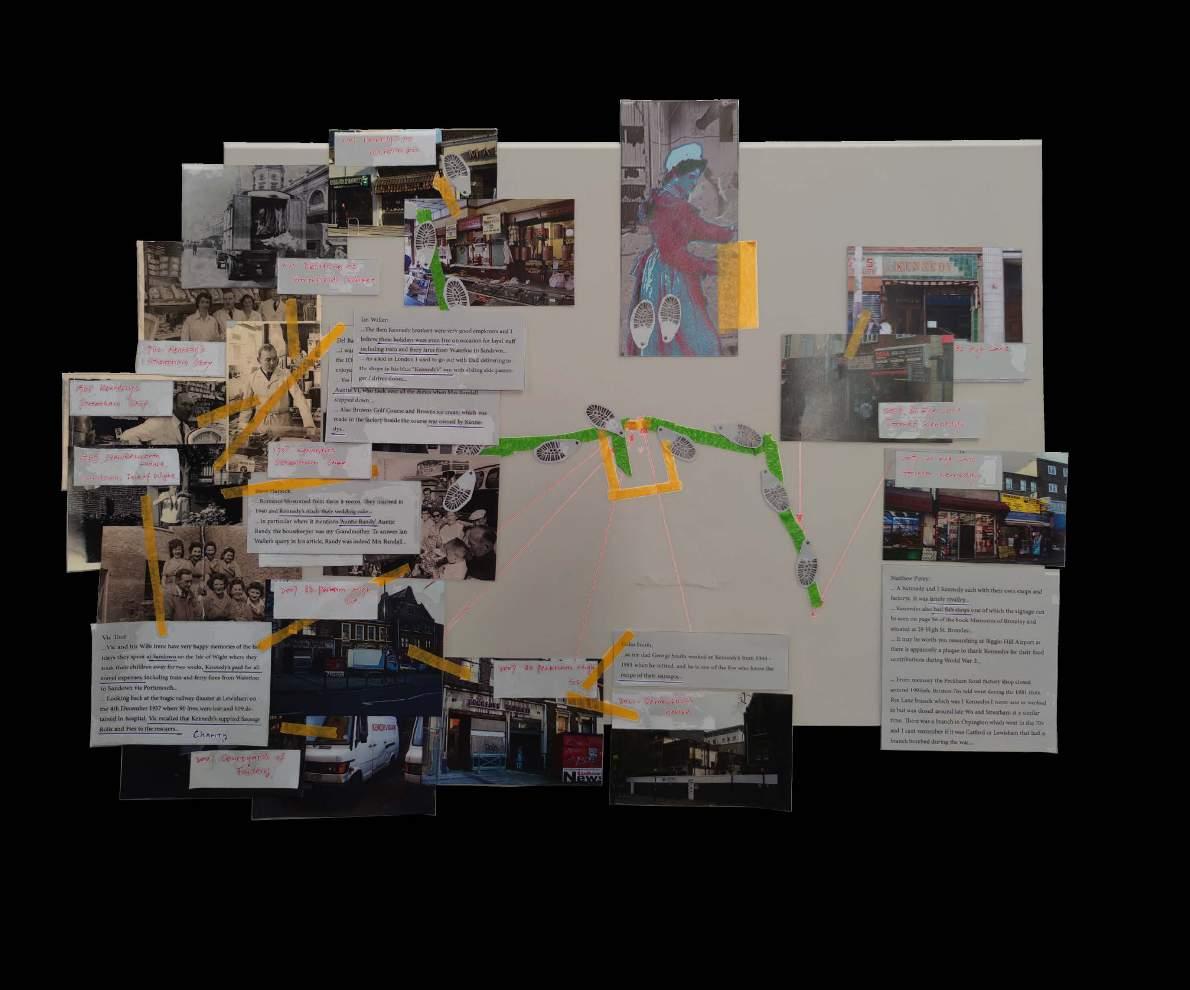

2.3.5.3 A representation of the space owner
Third character’s detective map
2.3.5.4 A representation of the passerby
Fourth character’s detective map

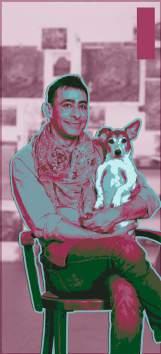
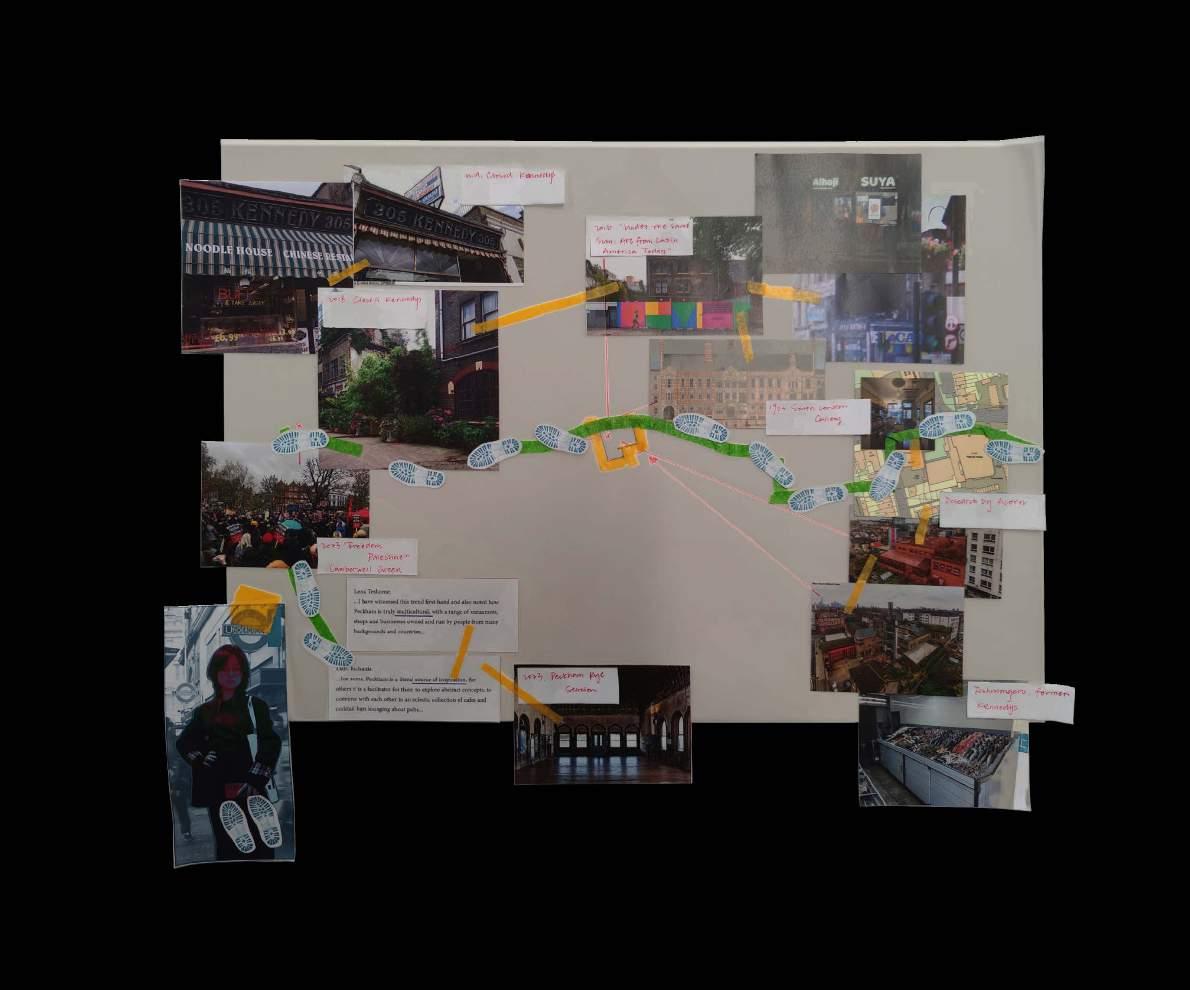


2.3.6 In the mist of history
Seeing
However, in the mist of time, the detective cannot see each layer in isolation, but while getting rid of the distracting information, the detective reaches the truth.
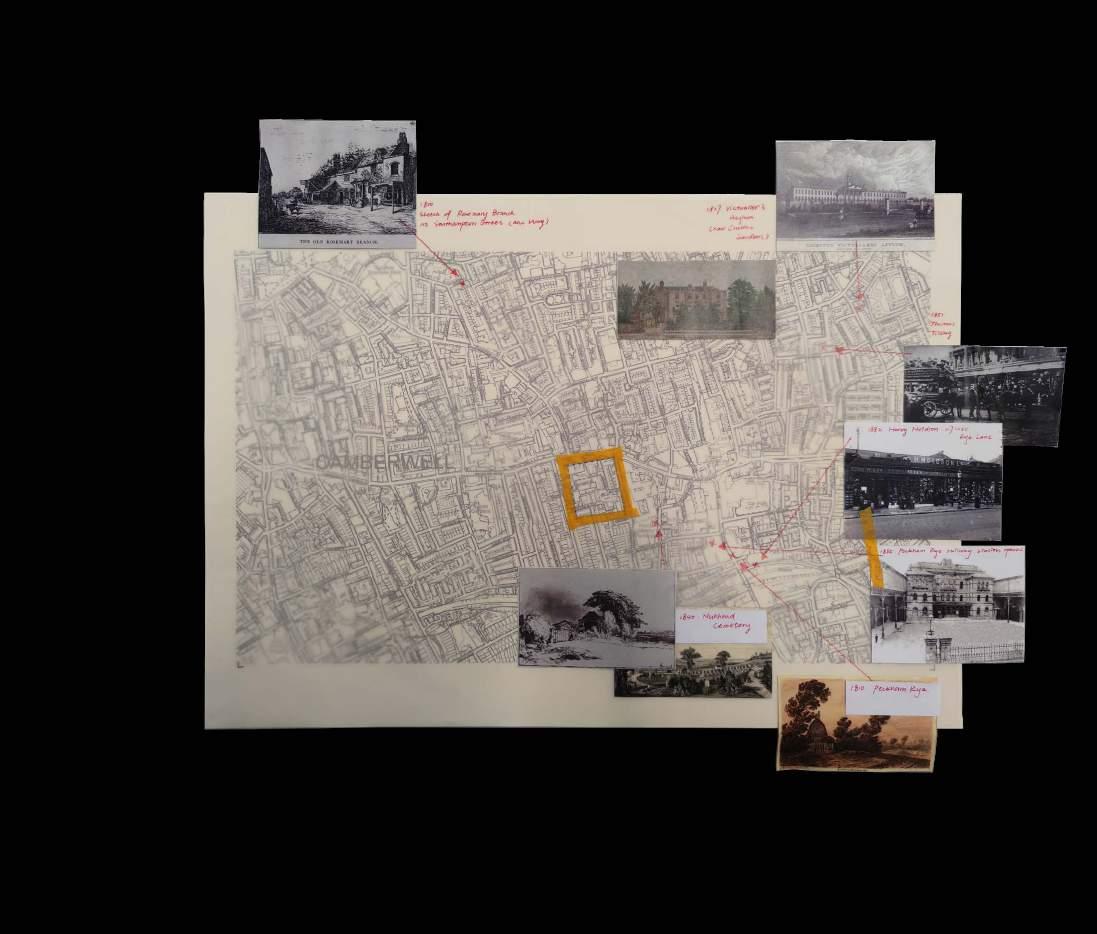

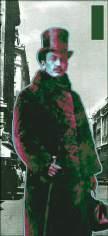
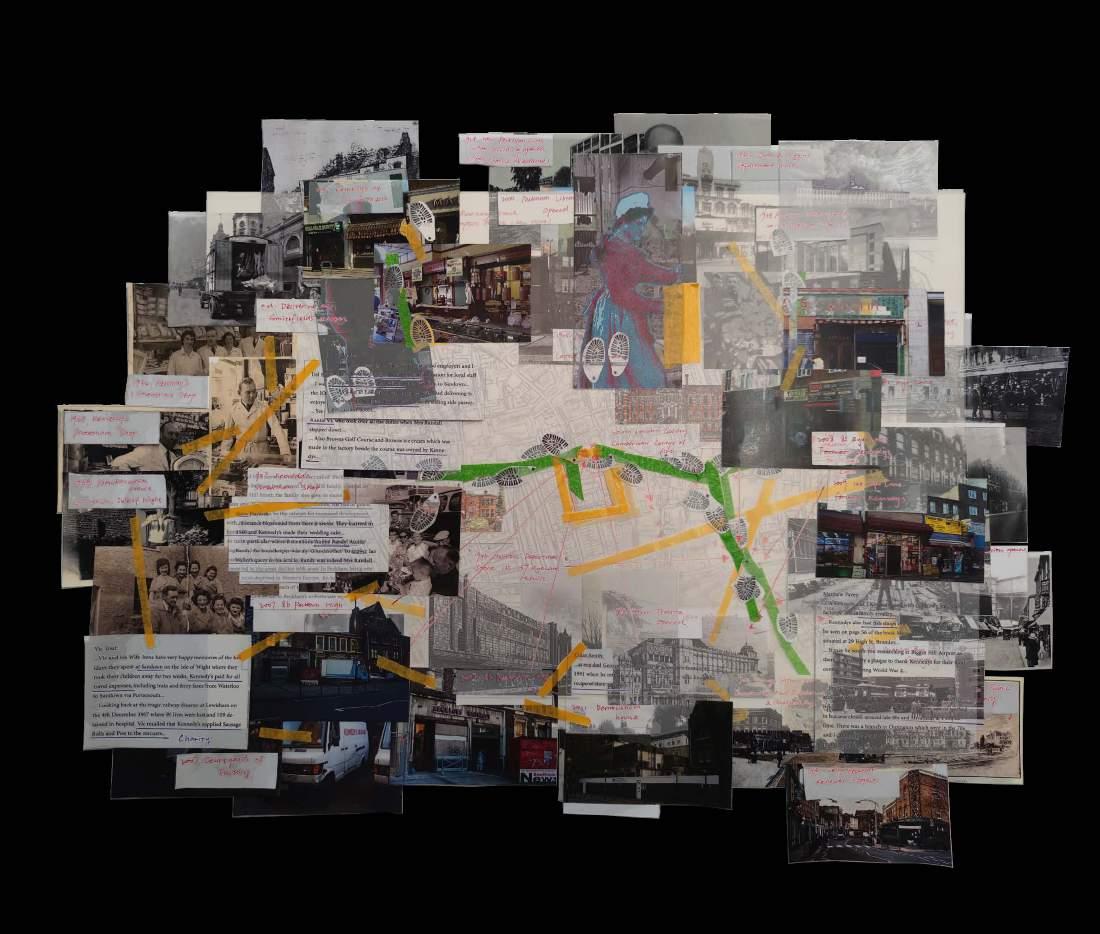

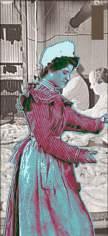









2.4.1 Detective club game
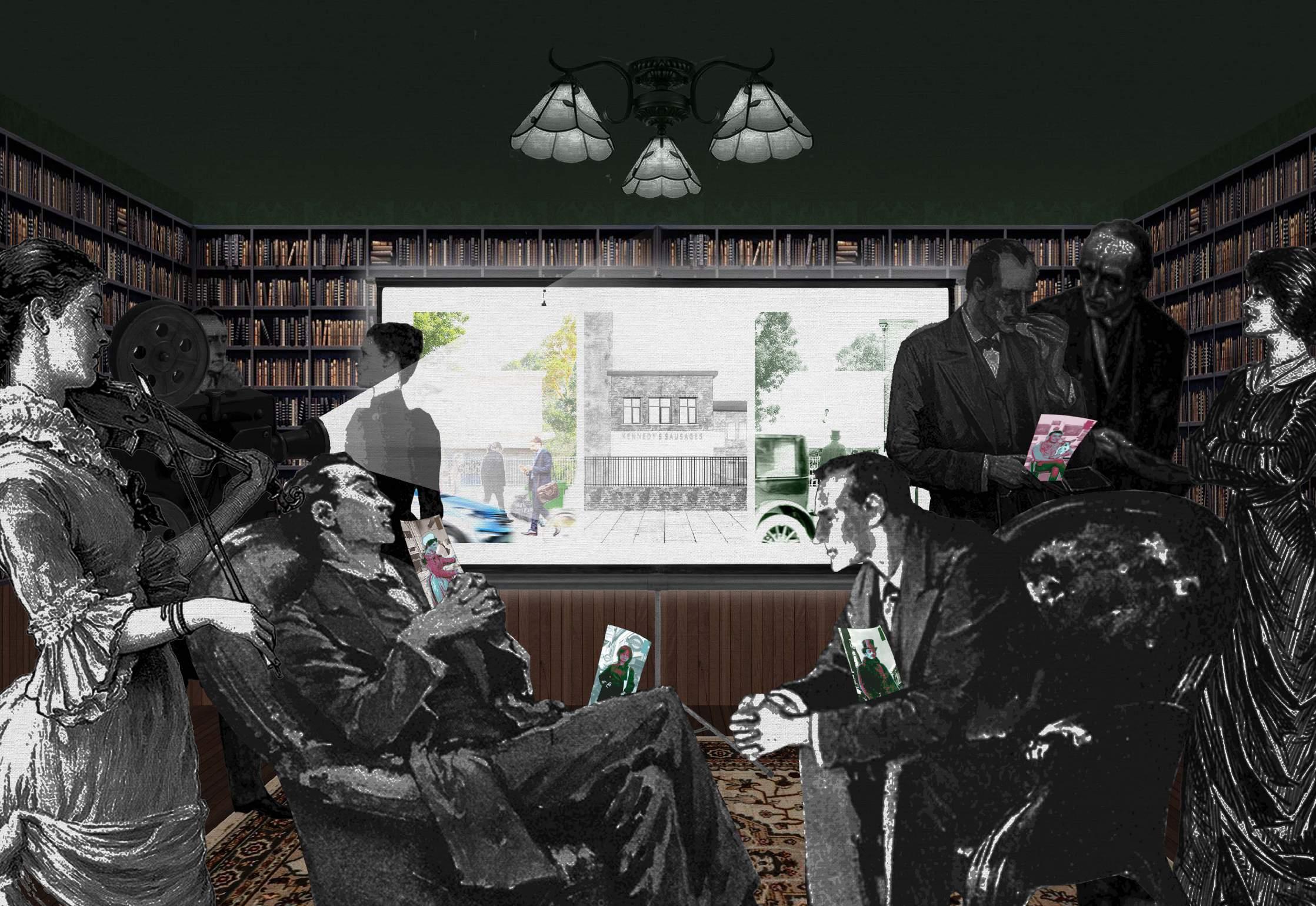
2.4.2 A materialized historical lens
How can a detective be scared away? The deduction is to be enjoyed. For the concept of the final product, decided to create an installation, as a prototype for the spatial design in unit 10, that allows the visitors to see the site like detective: from all different possibilities, they break down the situation and enjoy the process of deduction.
Experimenting with different structures, a small doublelayered picture frame was designed to allow multiple layers of pictures to be seen through, along with the real site behind. Through this installation, the audience can quickly gain an understanding of the past of the site.



2.4.3 Multi-layered filters
Exhibiting

2.4.4 Encounters across time and space
Diverse possibilities playing with the installation
To realize the design, several layers of acrylic panels were designed, facilitating people to test out different possibilities. A sense of déjà vu is conveyed, feeling like getting across the time and space, to the early past.
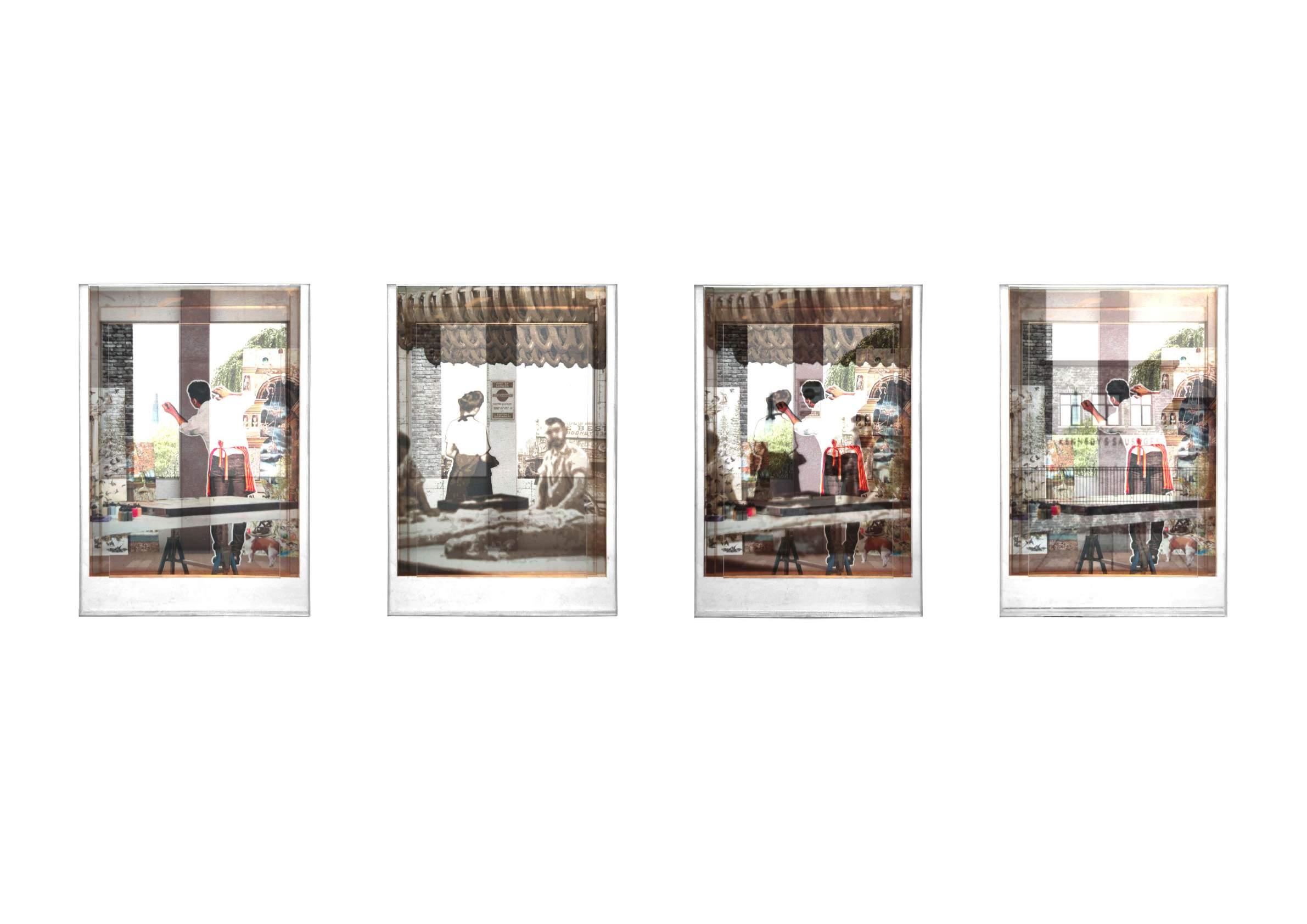
2.4.5 A dislocation of time and space
Seeing the site in person, through the filter of history
Bringing the installation to the site, the photos demonstrated the process of playing with the panels. The image of the time quadrants: the past, present and future, can be seen from reality and imagination.

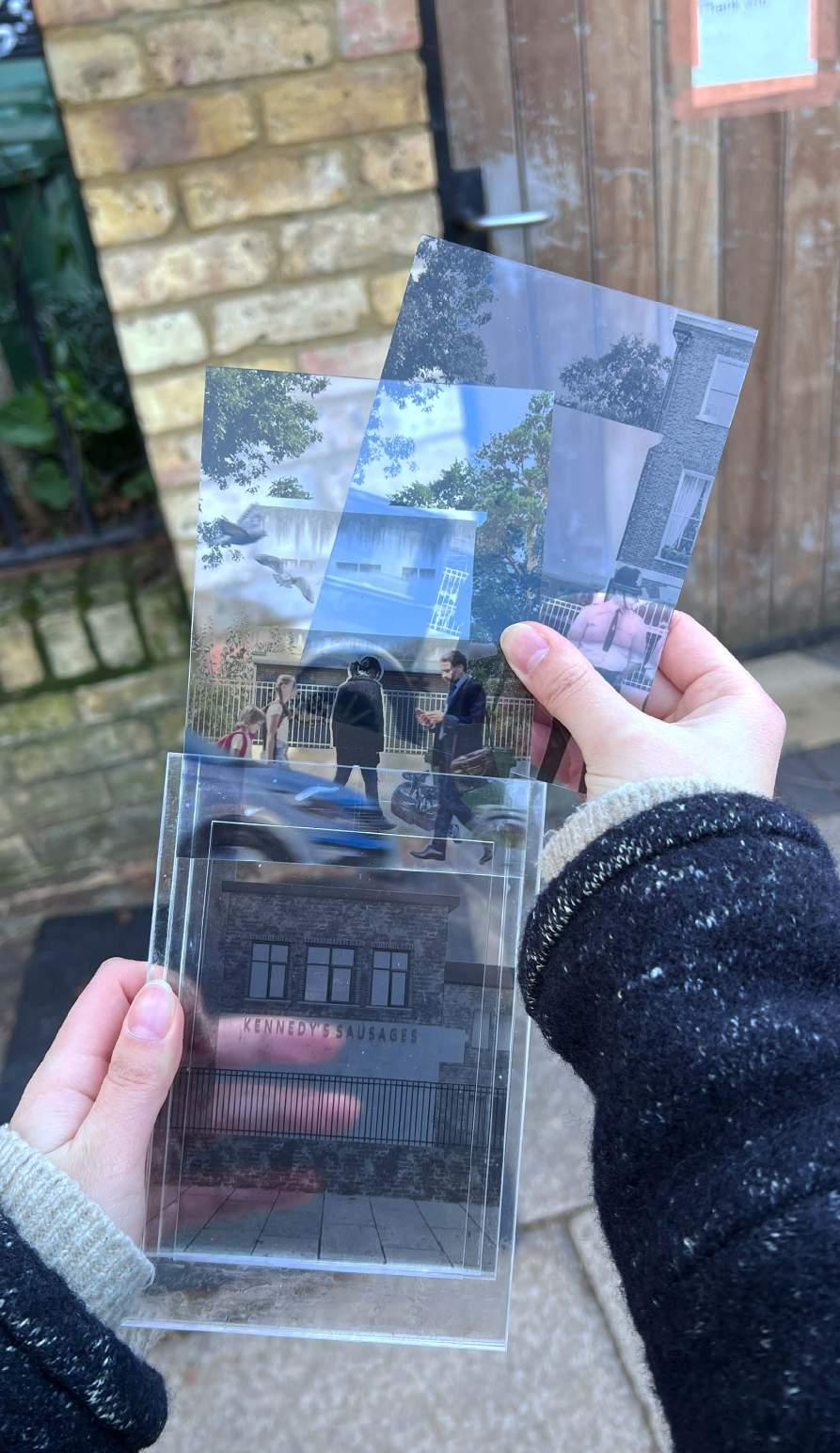

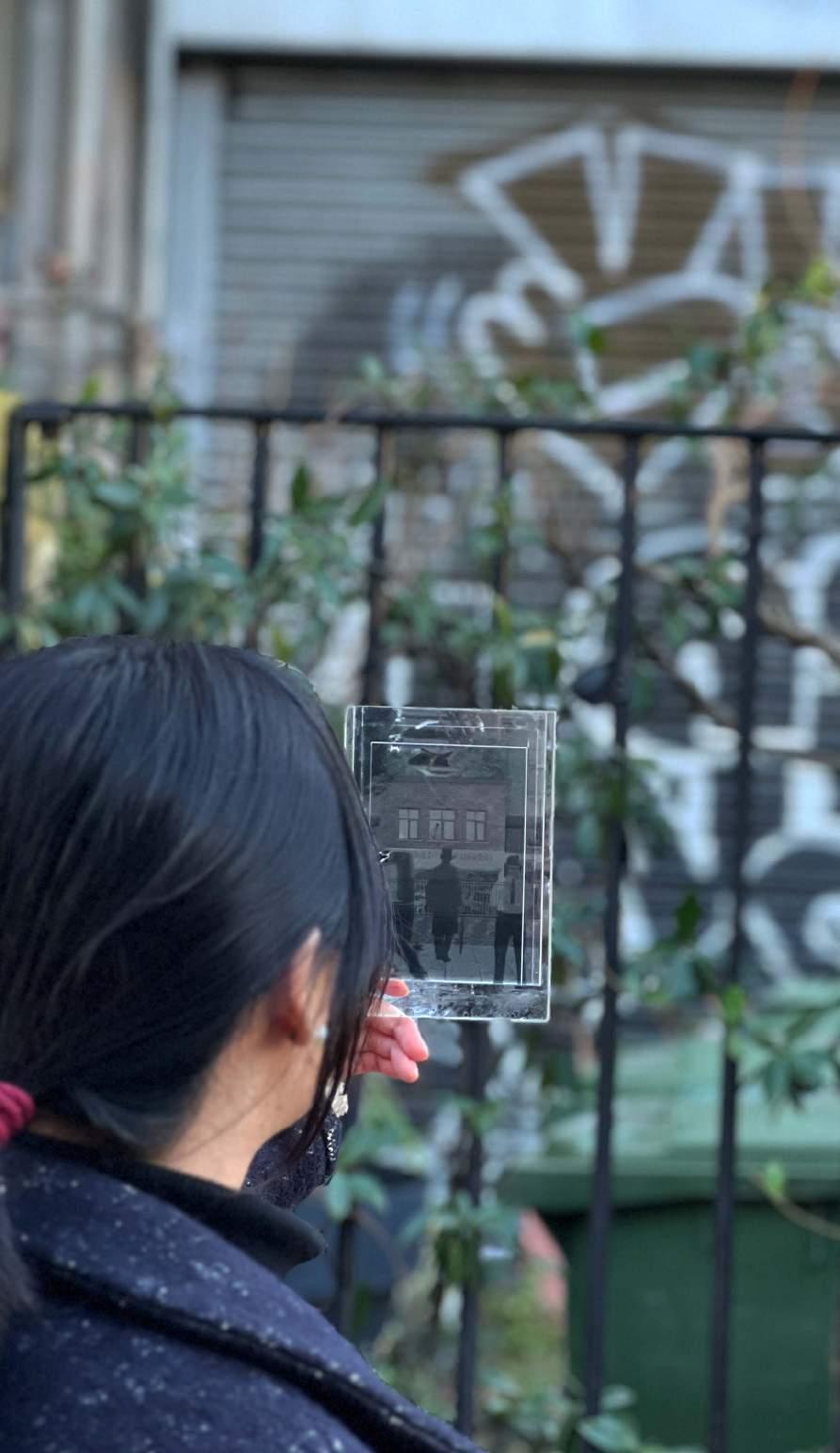





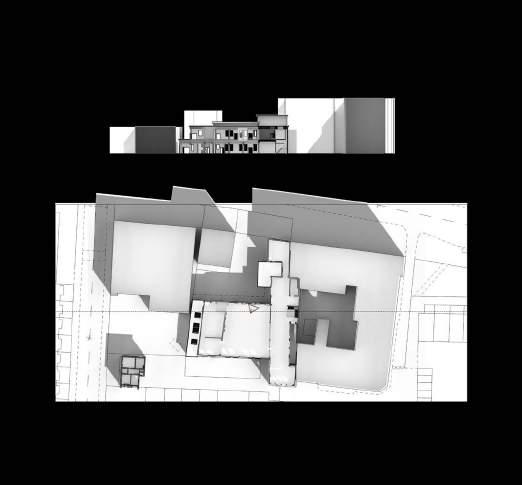

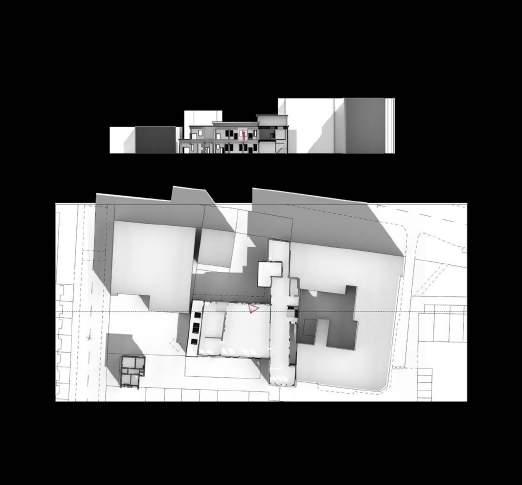

2.5.2 From the backyard of the factory
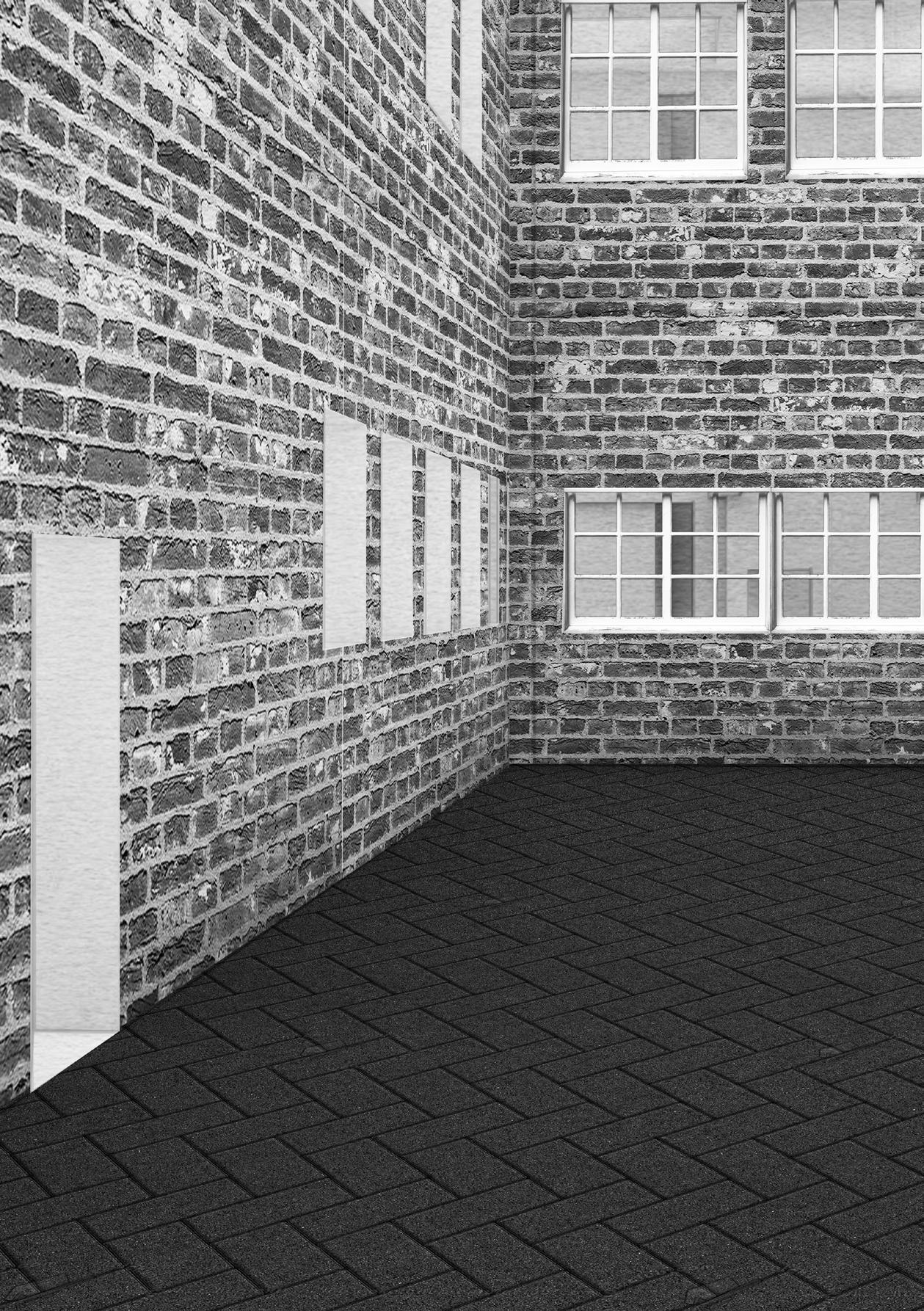
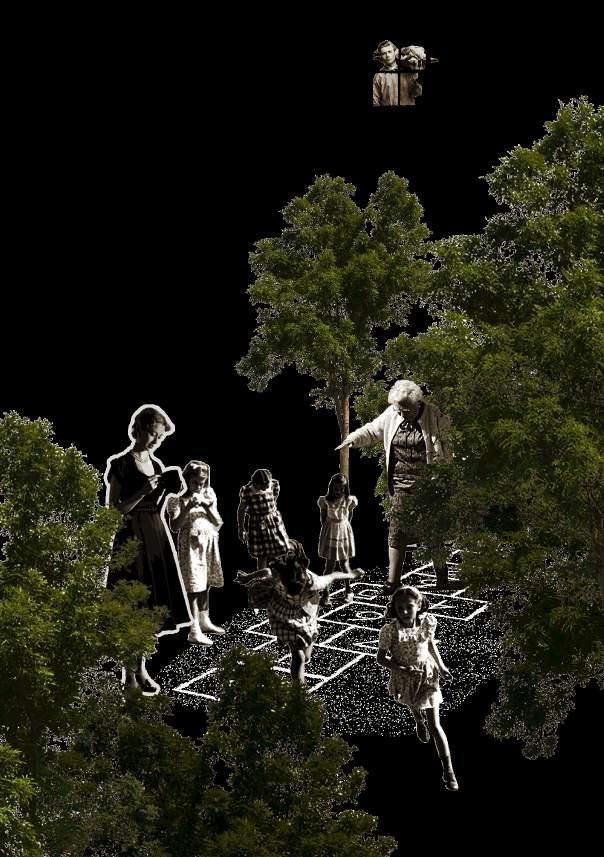




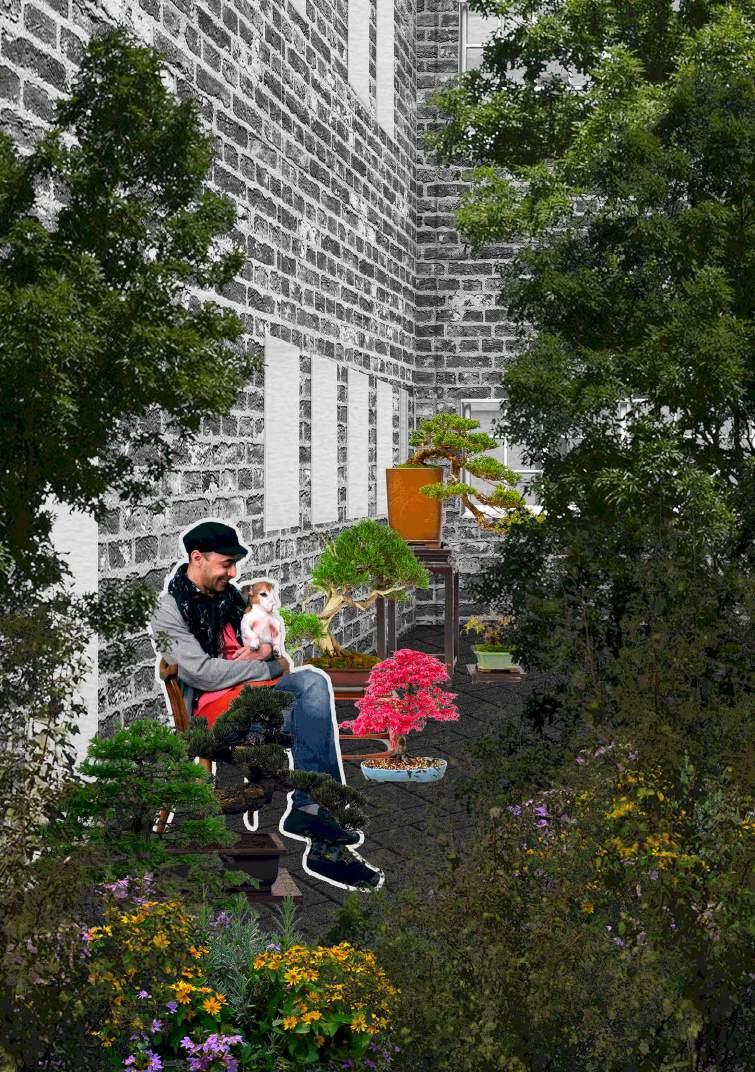
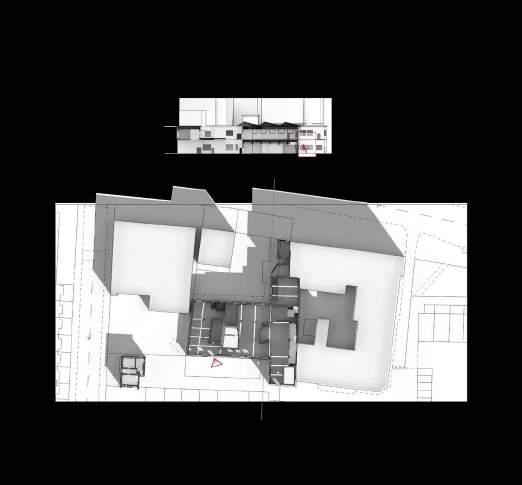



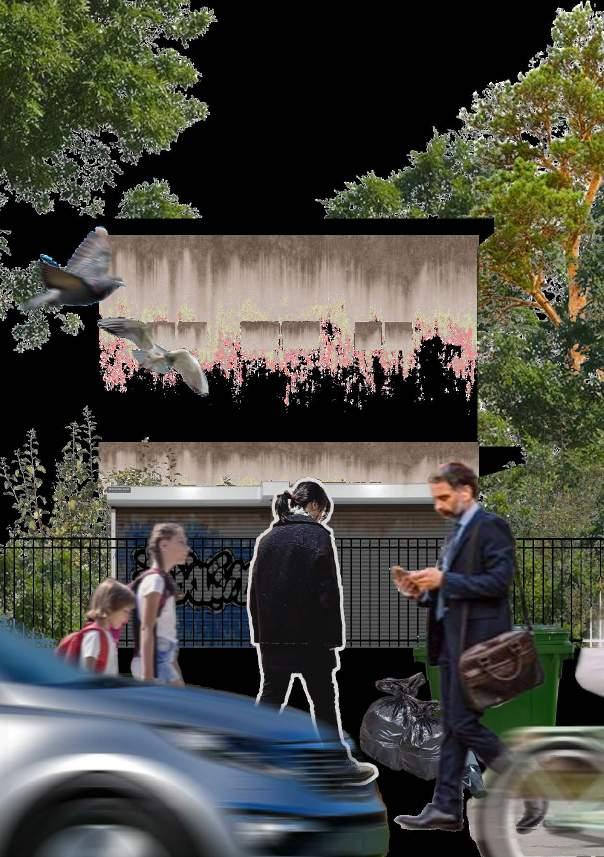

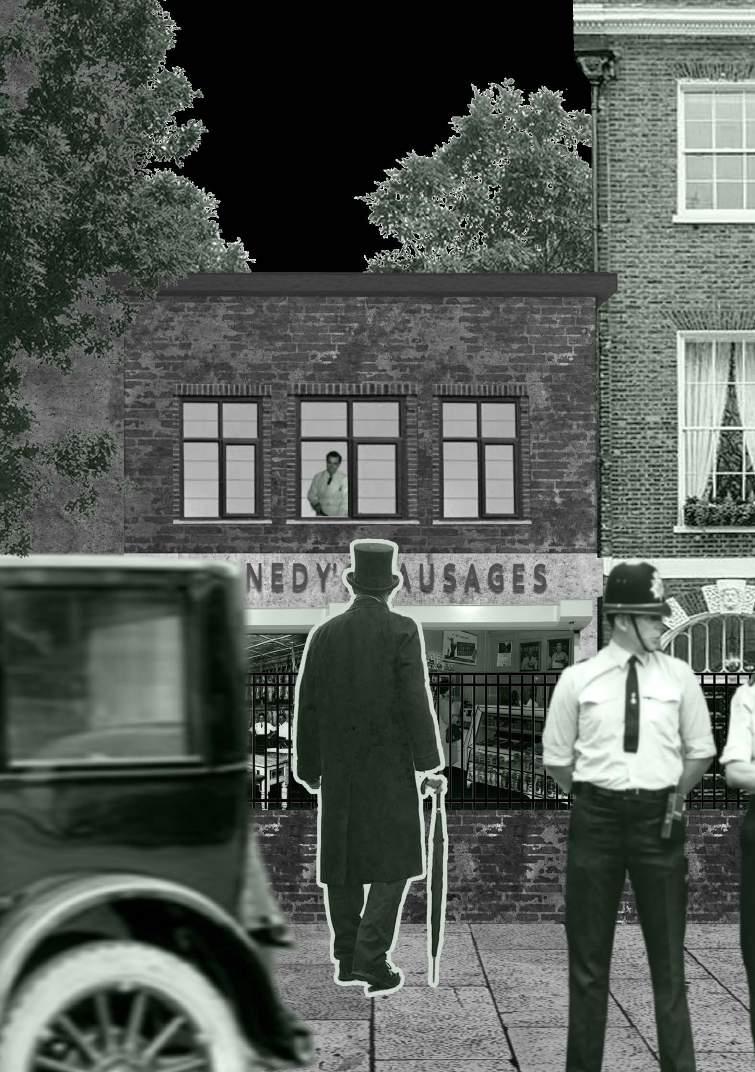

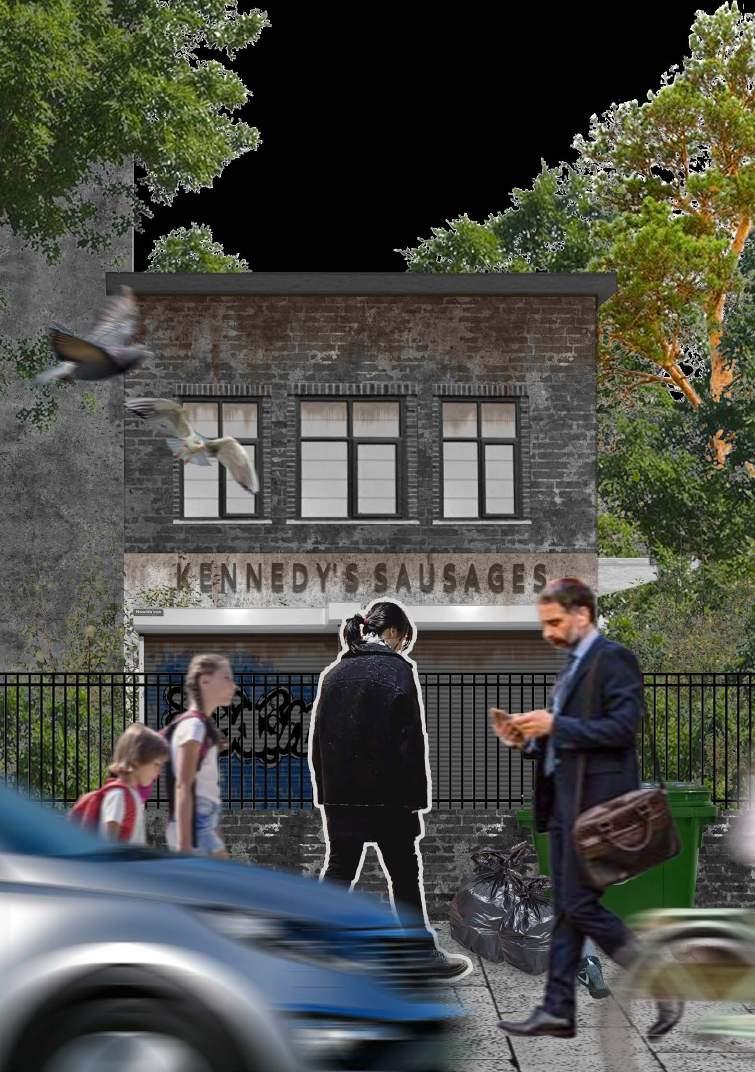






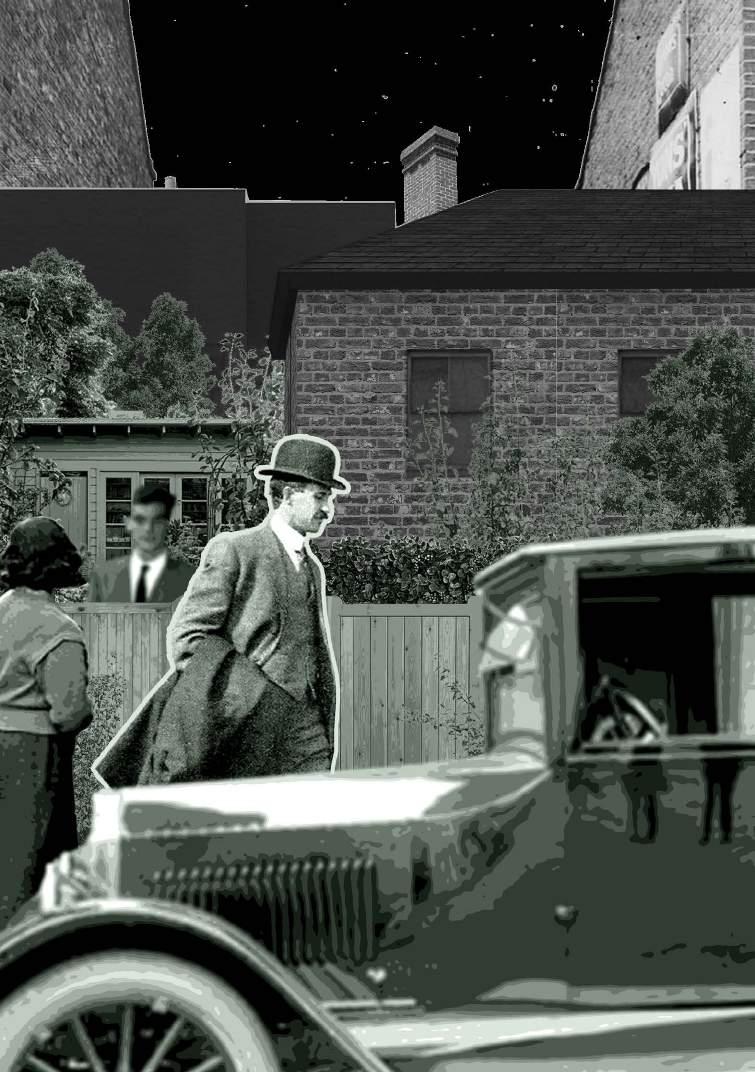
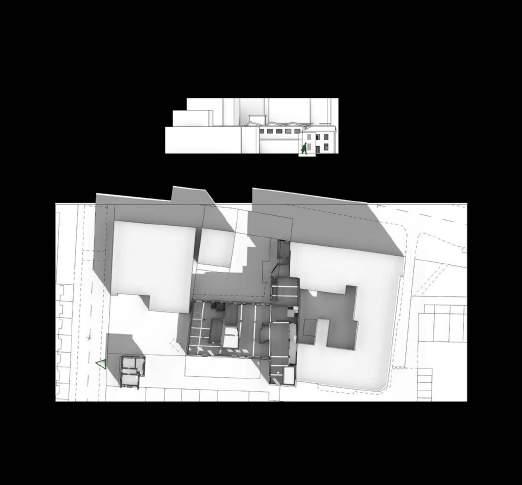
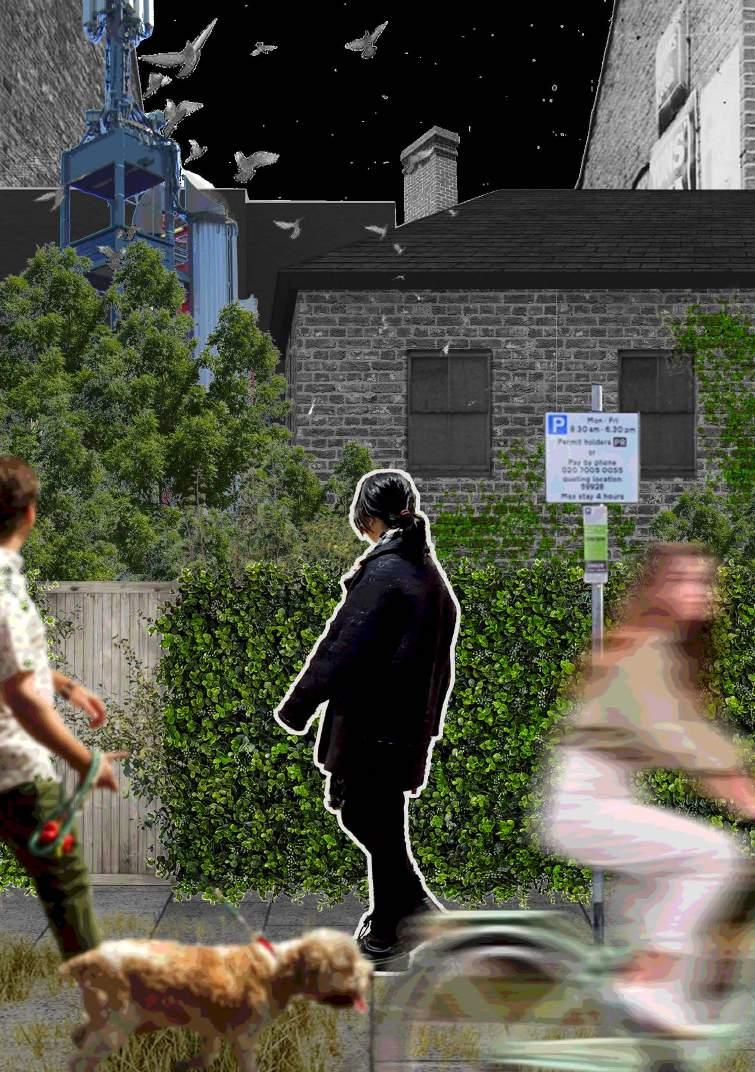
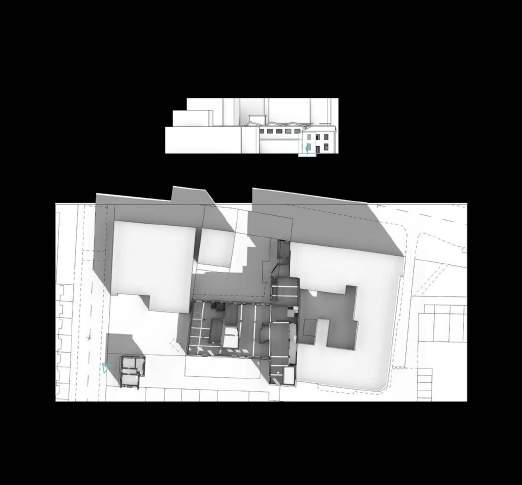

Reference list
DARK DREAMS INC. (2021). Peckham’s Finest - Memories of Camberwell and Peckham. [online] www.youtube.com. Available at: https://www.youtube.com/ watch?v=ocBwiPhrDvI&t=7s [Accessed 19 Jan. 2024].
Frist Art Museum (2023). Artist’s Perspective: Raqib Shaw discusses his exhibition at the Frist Art Museum. [online] www.youtube.com. Available at: https:// www.youtube.com/watch?v=wi7692Y6pVI&t=21s [Accessed 19 Jan. 2024].
Manchester Art Gallery (2014). Raqib Shaw in studio 2013. [online] www. youtube.com. Available at: https://www.youtube.com/watch?v=yv6rPZYLumw [Accessed 19 Jan. 2024].
Mclaughlin, R. (2016). Raqib Shaw: really don’t give fuck about the so-called contemporary art world’. [online] www.studiointernational.com. Available at: https://www.studiointernational.com/raqib-shaw-i-really-dont-give-a-fuckabout-the-so-called-contemporary-art-world-interview Pace Gallery (2023). Immerse in Raqib Shaw’s Diaristic and Dreamlike Paintings. [online] www.youtube.com. Available at: https://www.youtube.com/ watch?v=EMgmuEvIGOg [Accessed 19 Jan. 2024]. Shaw, R. (2018). Raqib Shaw. [online] Raqib Shaw. Available at: https://raqibshawstudio.com/. South London Club. (n.d.). Brief History of Peckham. [online] Available at: https://www.southlondonclub.co.uk/blog/a-brief-history-of-peckham South London Gallery (n.d.). Walk Talk It: John Passmore Edwards. [online] South London Gallery. Available at: https://www.southlondongallery.org/ projects/john-passmore-edwards-walk/ [Accessed 19 Jan. 2024]. Tate (2018). Raqib Shaw ‘Taking Craft to Crazy, Romantic Extreme’ TateShots. [online] www.youtube.com. Available at: https://www.youtube.com/ watch?v=NtKLOWxXV6U&t=420s [Accessed 19 Jan. 2024]. Thaddaeus Ropac. (n.d.). Raqib Shaw, Self portrait in the study at Peckham (A reverie after Antonello da Messina’s Saint Jerome) 2014. [online] Available at: https://ropac.net/artists/81-raqib-shaw/works/11240-raqib-shaw-self-portraitin-the-study-at-peckham-a-2014/ [Accessed 19 Jan. 2024].
White Cube (2017). In the Gallery: Raqib Shaw on ‘Absence of God’ White Cube. [online] www.youtube.com. Available at: https://www.youtube.com/ watch?v=rH6gKu9Ocmc [Accessed 19 Jan. 2024].
White Cube (2022). In Focus: Sir Norman Rosenthal on Raqib Shaw’s ‘The Retrospective 2002 2022’ White Cube. [online] www.youtube.com. Available at: https://www.youtube.com/watch?v=VuMzEnGuxNc [Accessed 19 Jan. 2024].
www.routebus537.veryold.net. (n.d.). Kennedy’s Sausages and Pies 1877 2007. [online] Available at: http://www.routebus537.veryold.net/kennedyscont.html [Accessed 19 Jan. 2024]. www.southlondonguide.co.uk. (n.d.). A Timeline History of Peckham with prints and photos. [online] Available at: http://www.southlondonguide.co.uk/ peckham/history.htm

2.6.2 Image list
Figure The detective’s Toolkit
Figure Four views of the shoe
Figure Collage: Tracing back to the shoes’ owner from evidence
Figure The detective map around Peckham
Figure Constructing characters from evidence
Figure Information sources used for detective investigation of the characters
Figure The perspective of the future detective: seeing the present and past through
Figure A gentleman from the 19th century
Figure A female worker working at the sausage factory in Peckham, from the end of the 20th century
Figure 10 The artist Raqib Shaw, who occupies the factory currently
Figure 11 Zijue, a student living in London currently, investigating the history of Peckham for her project
Figure 12 Seeing the site at the end of the 19th century
Figure 13 Seeing the site at the beginning of the 21st century
Figure 14 Seeing the site from the inside of the factory, 2023
Figure 15 Seeing the site from the outside of the factory, 2023
Figure 16 Collage: The cultural entertainment of performing detectives
Figure 17 Axonometric diagram of the installation
Figure 18 The installation at the site, as an interactive detective game
Figure 19 The frame holding the acrylic panels
Figure 20 Transparent background acrylic panels
Figure 21 Transparent narrative acrylic panels
Figure 22 Matching pair
Figure 23 Matching pair
Figure 24 Overlapping time
Figure 25 Story dislocation
Figure 26 Seeing the site through the lens of history
Figure 27 First group of panels: from the inside of the factory
Figure 28 20th century: from the inside of the factory
Figure 29 2023: from the inside of the factory
Figure 30 Second group of panels: from the inside of the backyard
Figure 31 20th century: from the inside of the backyard
Figure 32 2023: from the inside of the
Figure 33 Third group of panels: from Peckham Road
Figure 34 19th century: from Peckham Road
Figure 35 2023: from Peckham Road
Figure 36 Fourth group of panels: from Talfourd
Figure 37 19th century: from
Figure 38 2023: from
Site Technical Drawings
3.1 Axonometric drawing

Axonometric
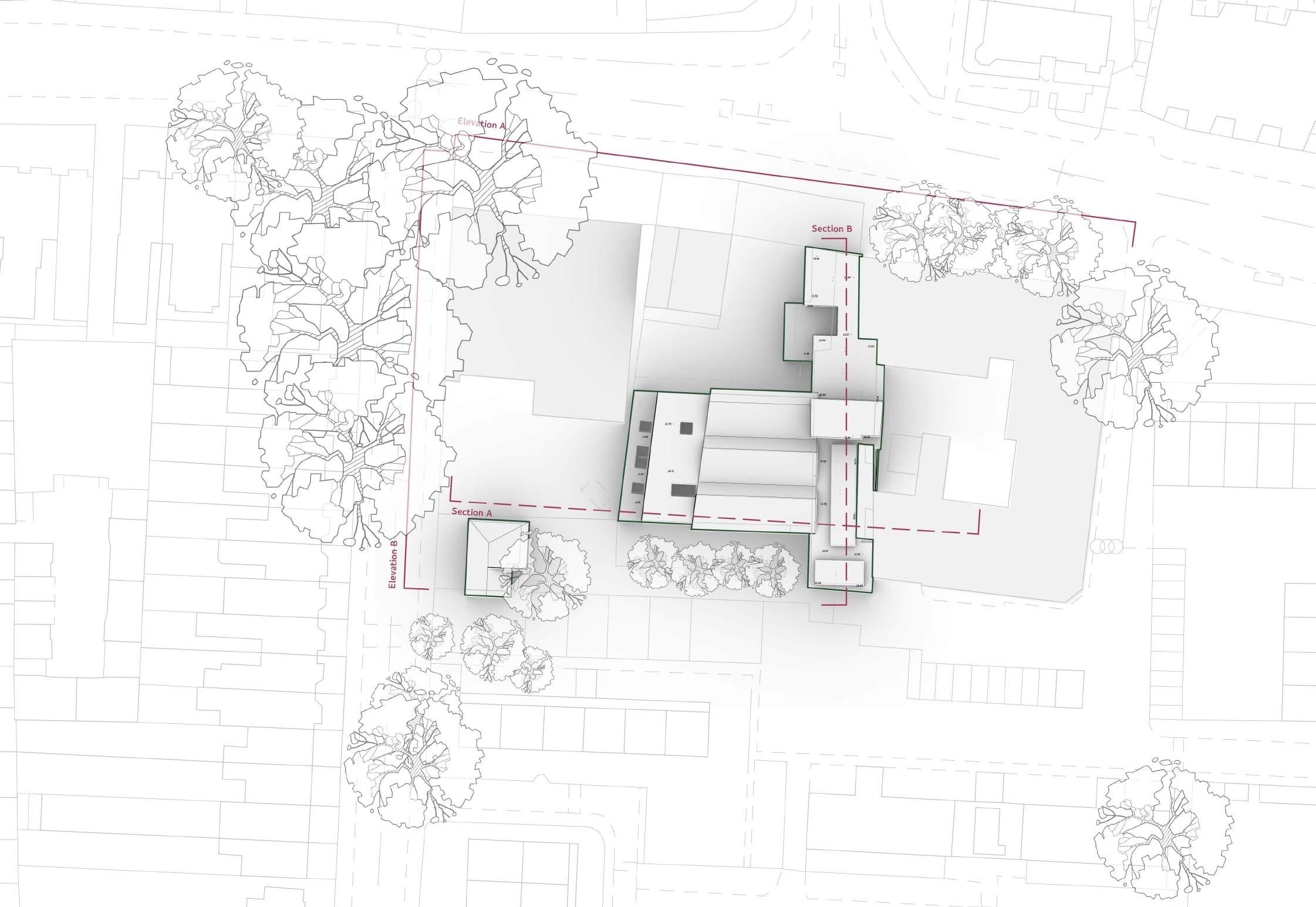



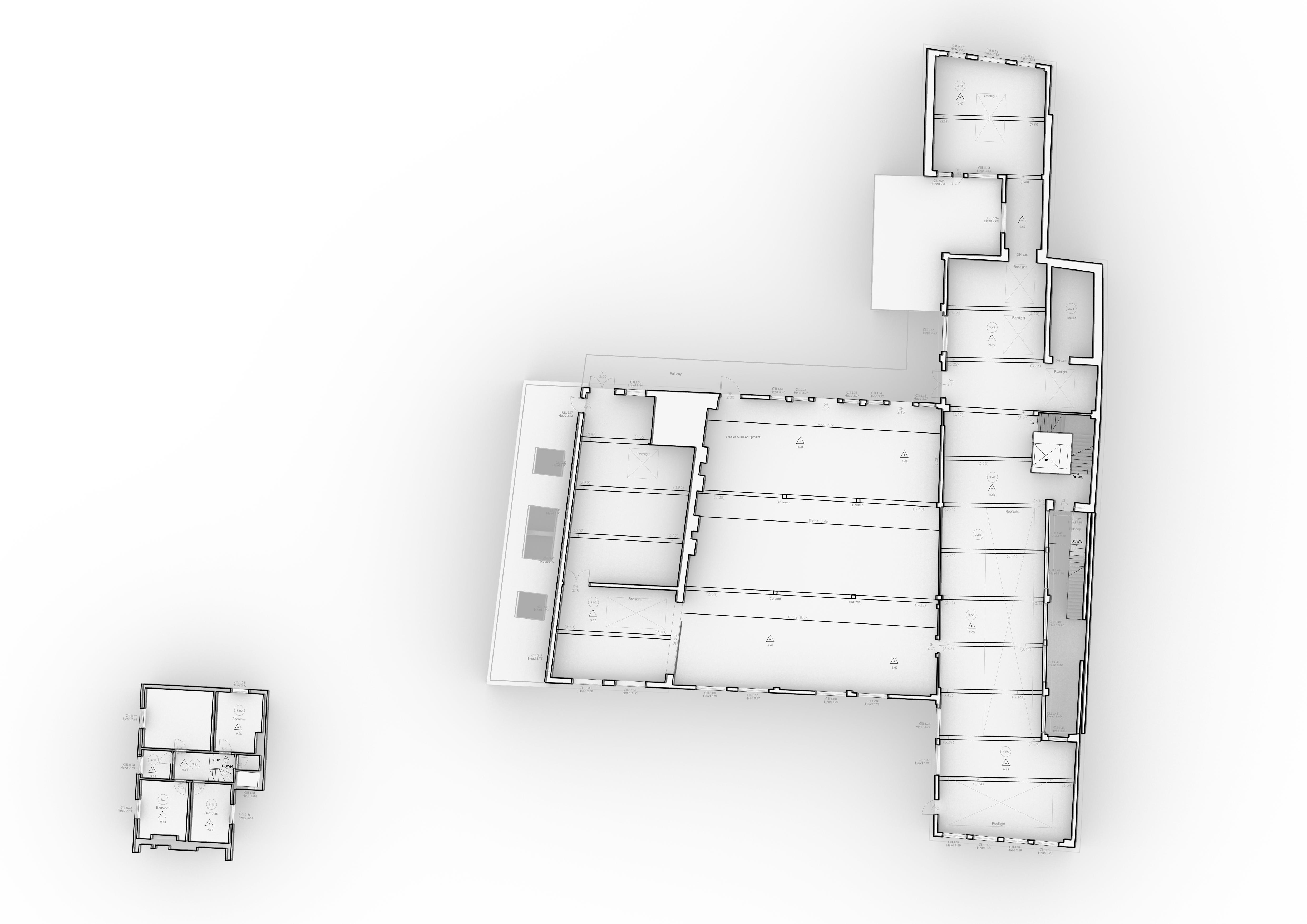


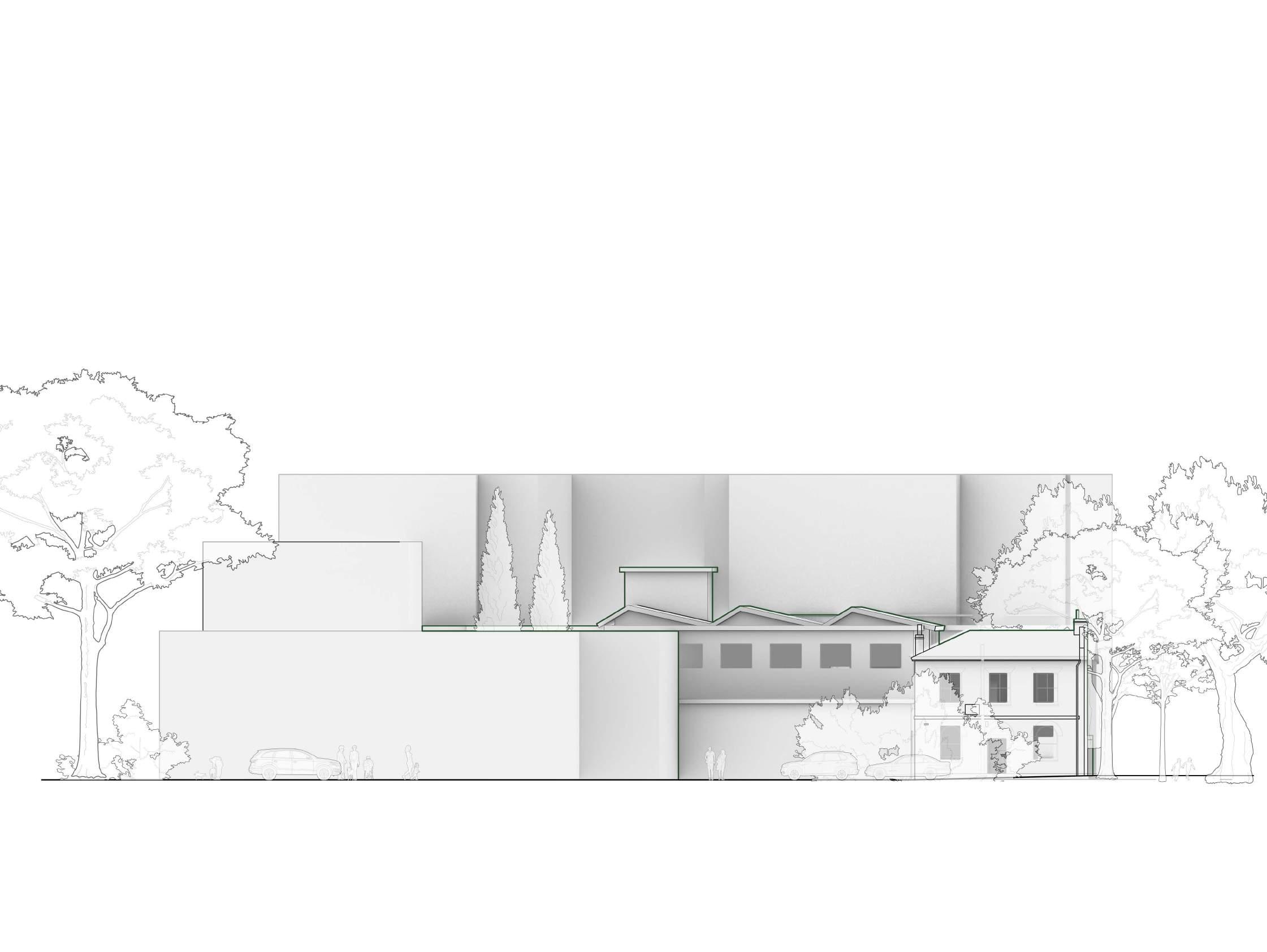

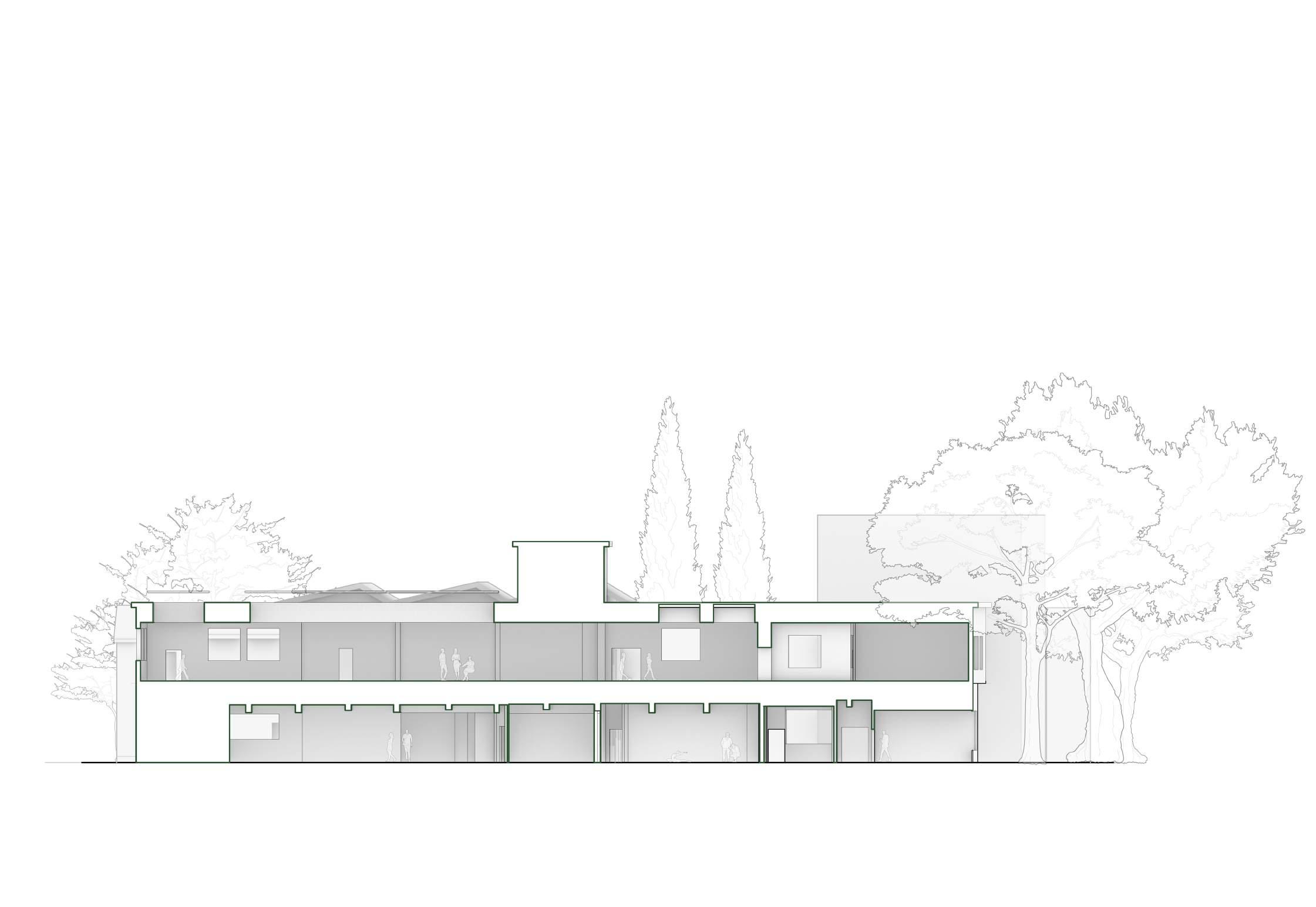
Unofficial History
4.0 To the past of Peckham

1. Project title: Unofficial History
2. Concept/Key ideas:
Through the study and research about the site and its history, I would like the design to exhibit a new perspective of the local history, by creating immersive experiences from other ages, and allowing interactions between the visitors and the past evidence, people could gain a better understanding of the past and have a vague prediction about their future, and creating a sense of belonging and cultural/historical recognition among the local residents.
Through writing the thesis, the knowledge about creating strong emotional resonance in a narrative space was studied and supported by precedents. With the historical support gained during the research in the visual essay, by localizing such methodologies with local material, culture, records, etc, a special narrative atmosphere targeting local residents could be created through spatial design, leading to a stronger sense of self-cognition.
3. Scale/type:
Archive library/historical museum, fulfilling social, educational and academic needs.
4. Location/condition:
Planning to use the main building at the site (Kennedy’s Sausage Factory). If not using the site, a large enough interior space would be considered.
5. Programme:
In the initial proposal, the facility will have 2 basic functions: the museum as the exhibition space, and the archive library as academic research and archive protection. Through creating these 2 facilities, the local history can be better researched, recorded, protected and conveyed, in order to make a strong localization and provide a socialization and education place for the local residents.

6. Users:
For educational and entertaining purposes: local students and people interested in local history
For academic purposes: Historians, researchers, scholars
7. Clients:
Local galleries and libraries such as South London Gallery, which is conducting historical research programmes, and local schools in need of educational trips for students.
8. Importance:
For an urban place with strong recognizable features, it is necessary to build a sense of belonging and a collective cognition of the place by talking about memories, history and stories. The design would allow an offline platform for communicating such information.
For the audience, they can access an innovative perspective to understand Peckham and its history and gain an expansion in their knowledge.
For scholars and researchers, especially locals, the museum and research facility could offer them new job opportunities and a chance to dig into local history, devoting themselves to the investigation of such professional and academic fields. Meanwhile, as the historical evidence could be better recorded, this information could benefit future studies, as they provide essential reliable records of the earlier past.
For sustainability, the museum could record the process of changes taking place in the natural and social environment in the UK, such as industry, social structure, transport and bio-diversity, etc. The importance of environmental protection and a tenet of sustainability could be conveyed through the museum.
